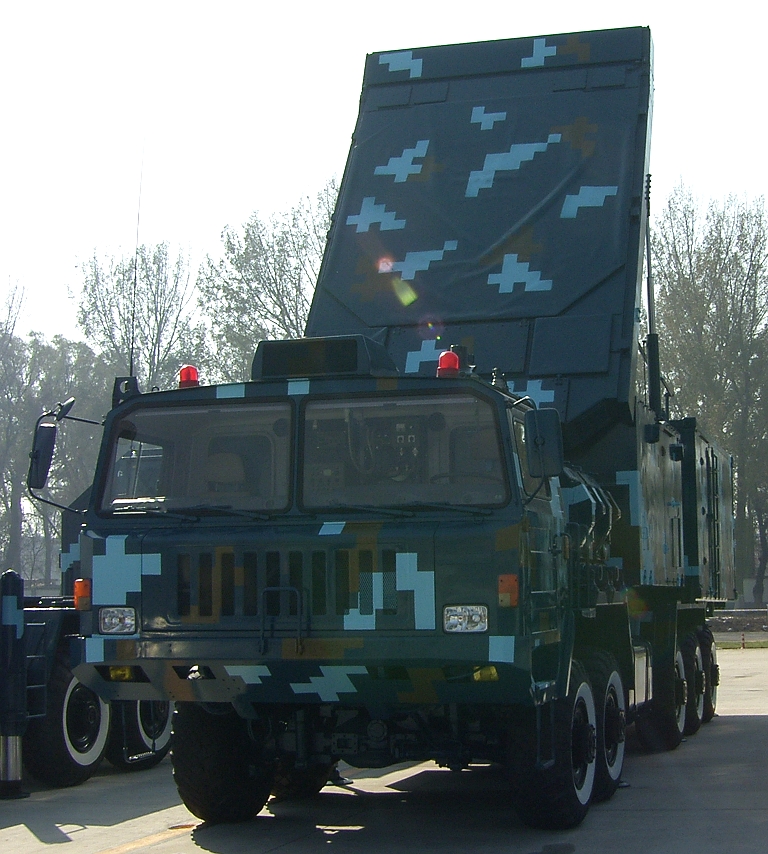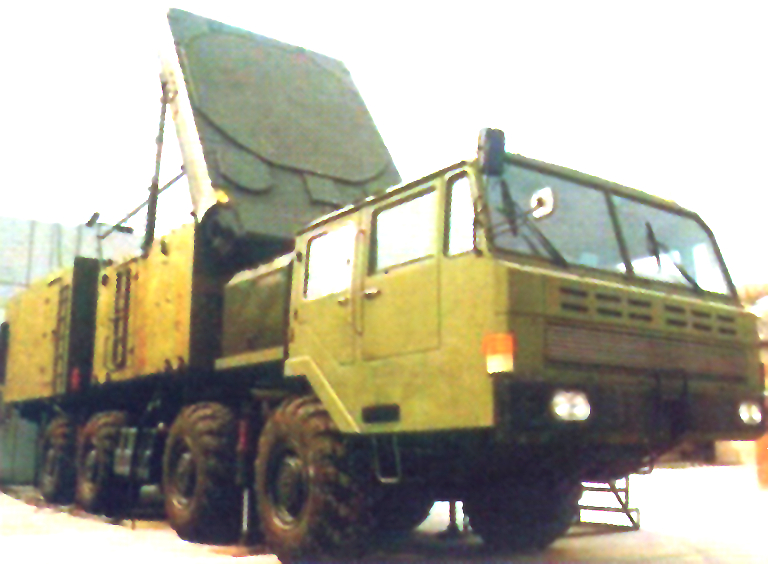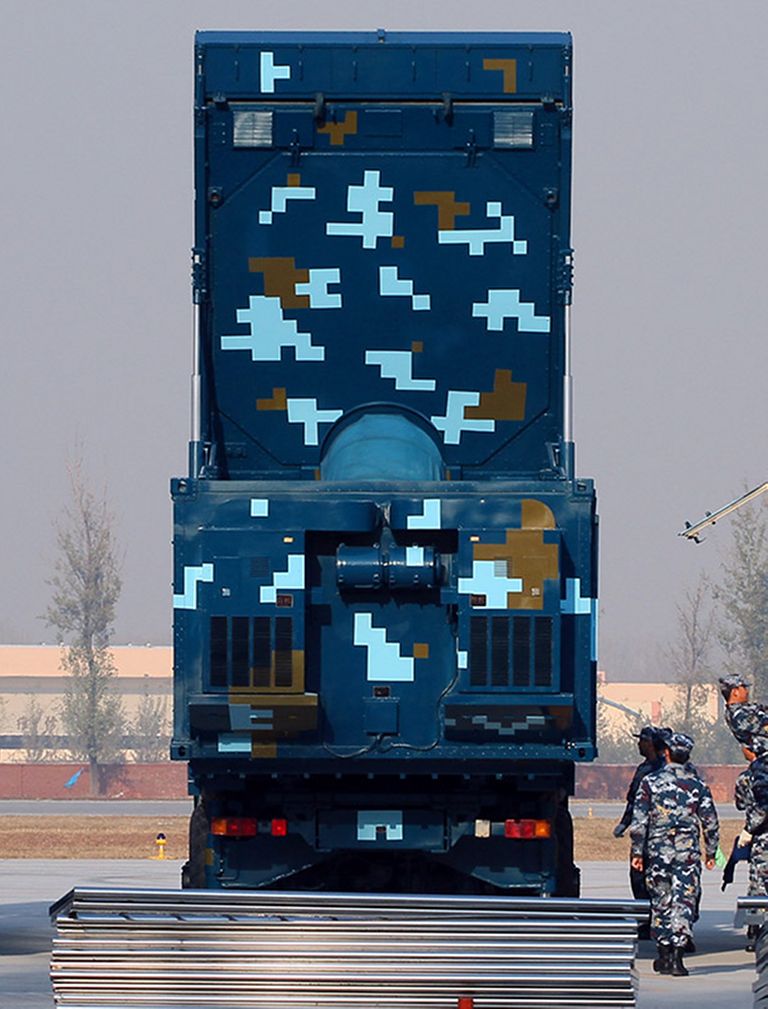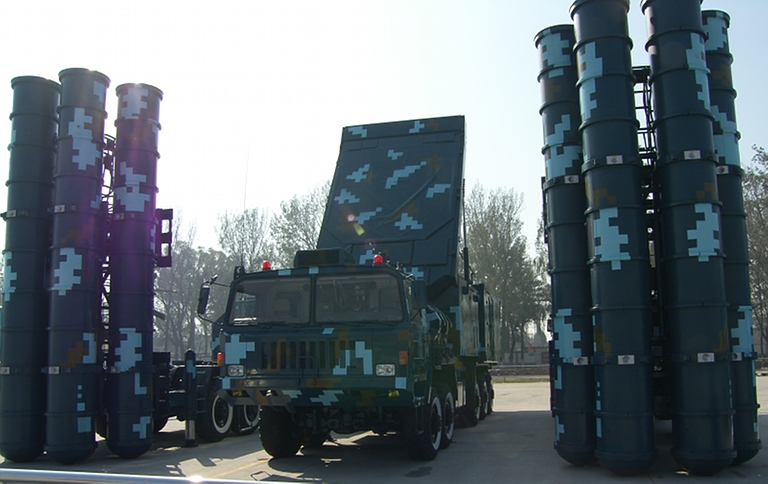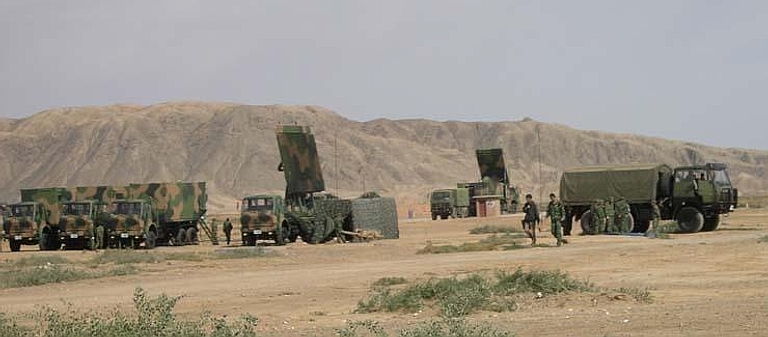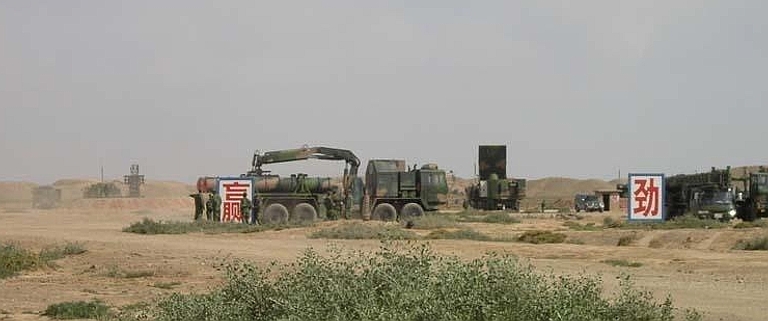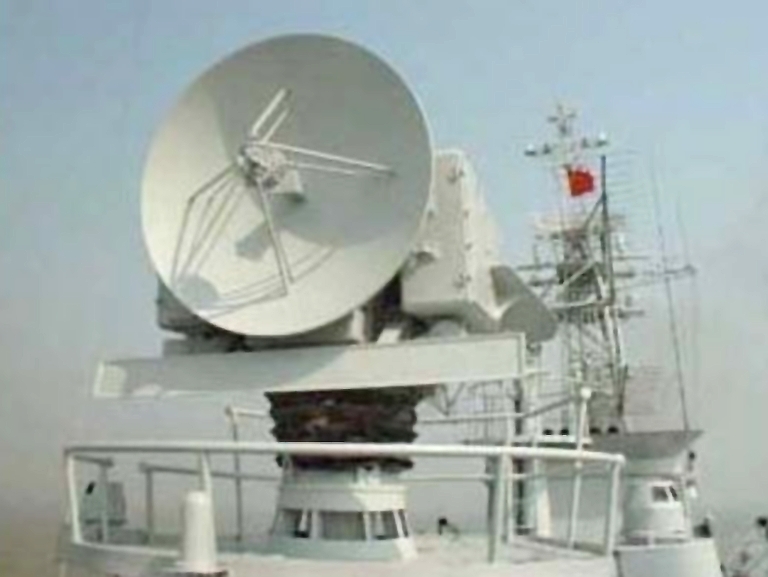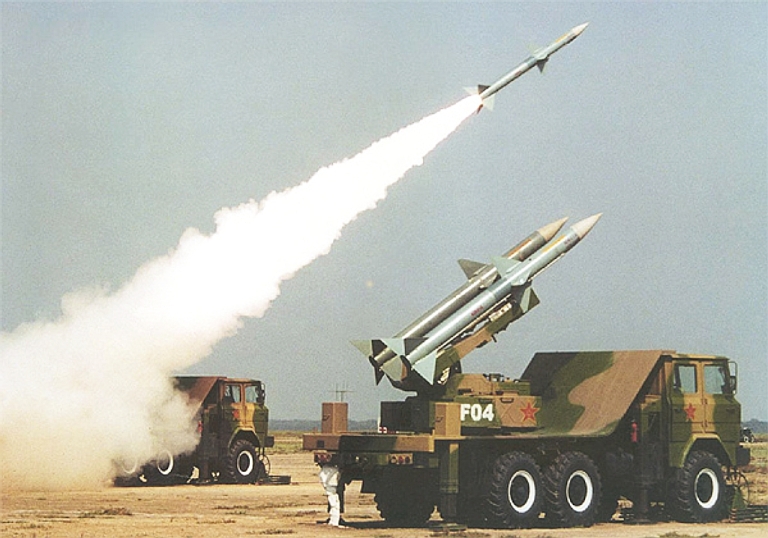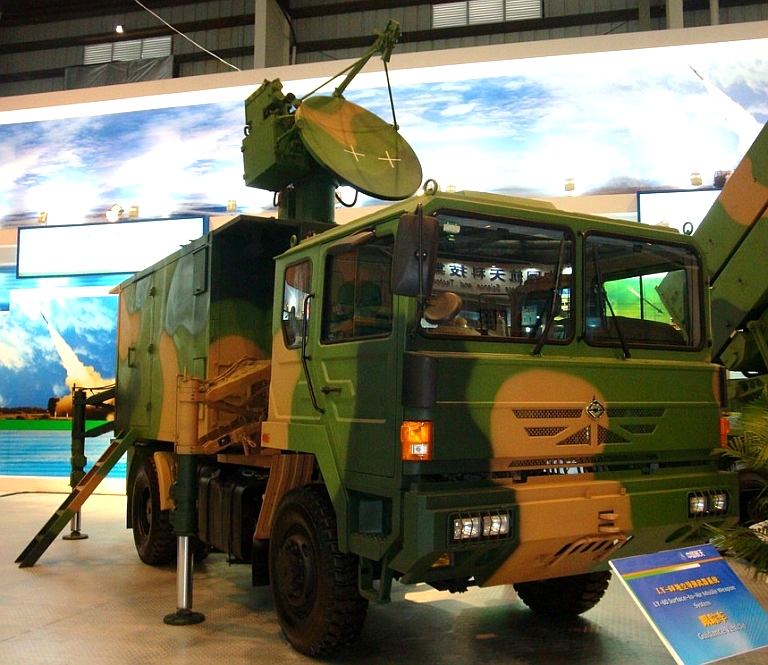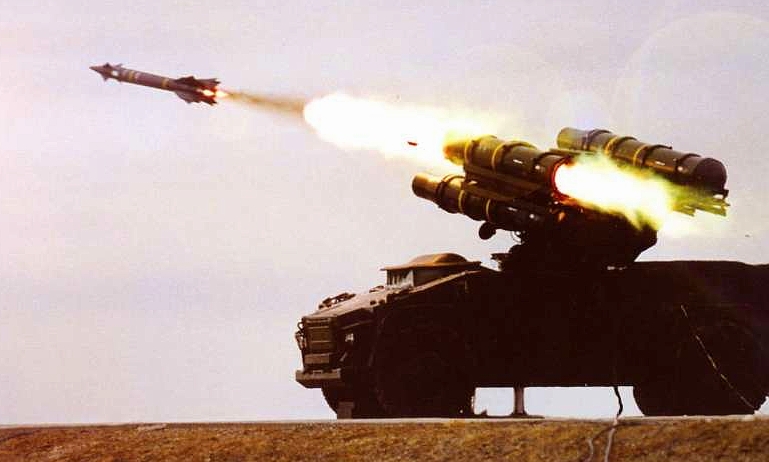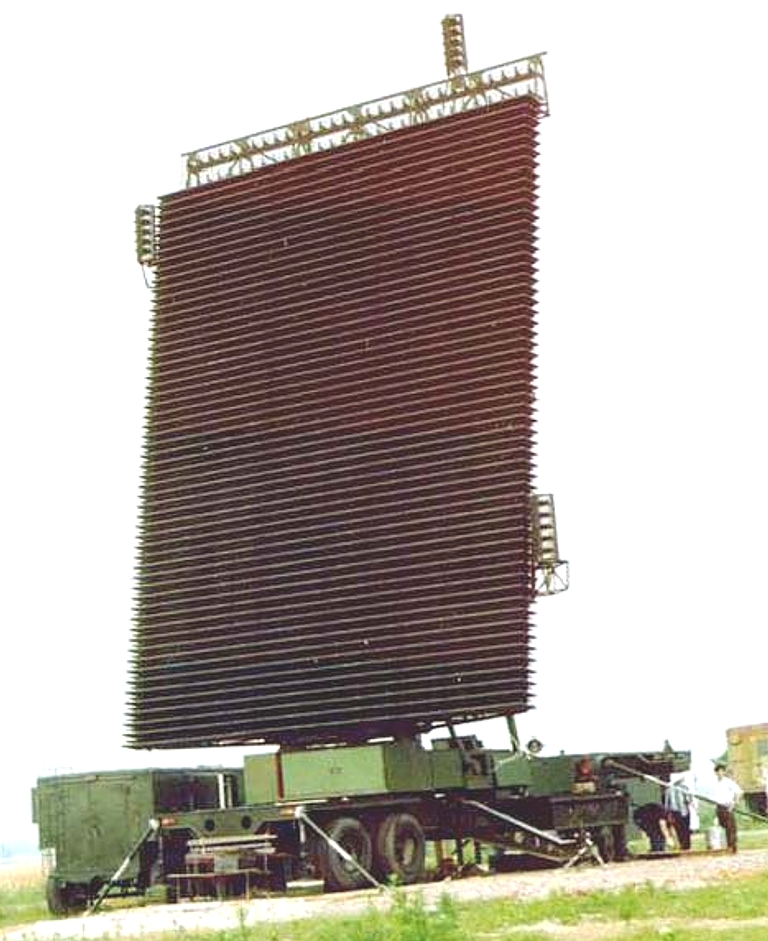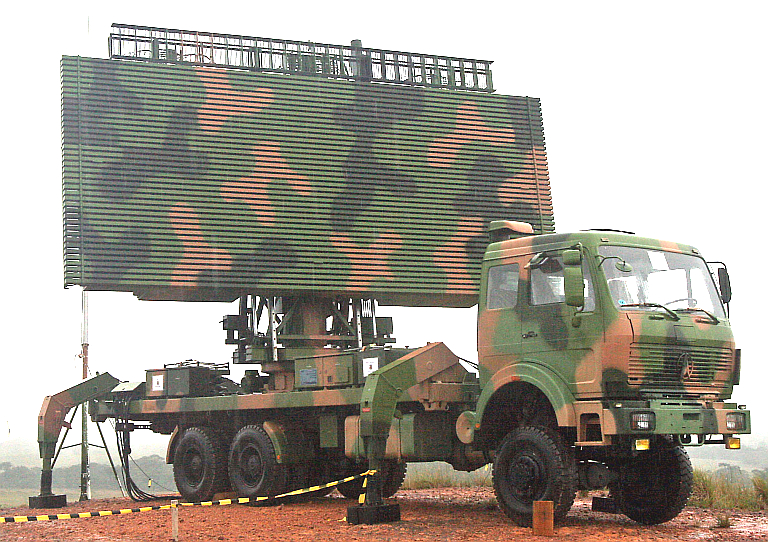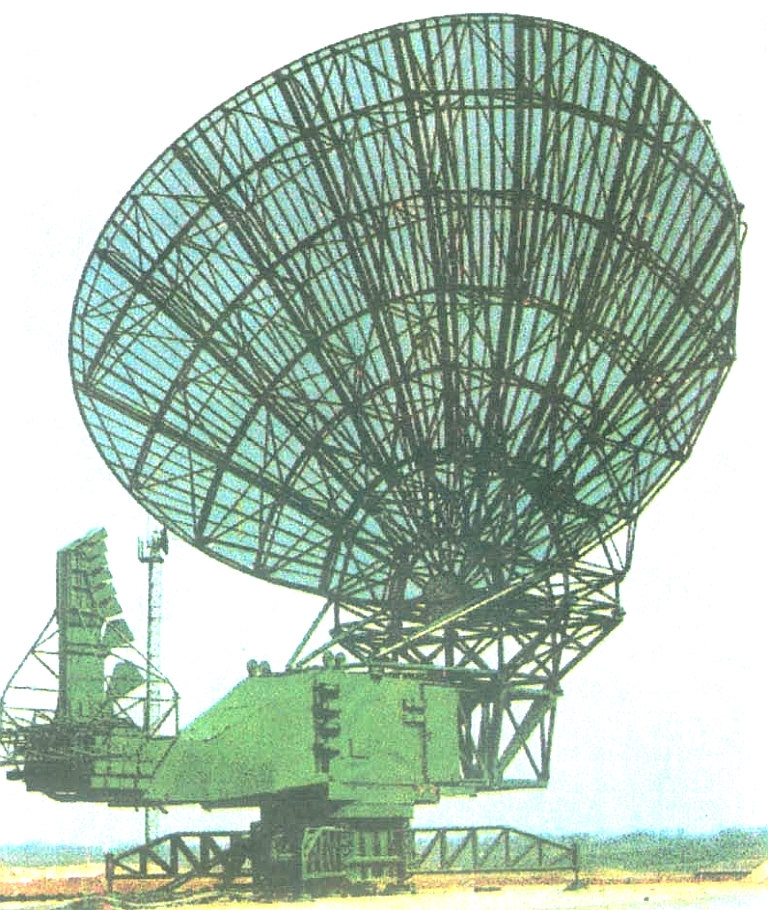|
||||||||||||||||||||||
![Home - Air Power Australia Website [Click for more ...]](APA/APA-Title-Main.png) |
||||||||||||||||||||||
![Sukhoi PAK-FA and Flanker Index Page [Click for more ...]](APA/flanker.png) |
![F-35 Joint Strike Fighter Index Page [Click for more ...]](APA/jsf.png) |
![Weapons Technology Index Page [Click for more ...]](APA/weps.png) |
![News and Media Related Material Index Page [Click for more ...]](APA/media.png) |
|||||||||||||||||||
![Surface to Air Missile Systems / Integrated Air Defence Systems Index Page [Click for more ...]](APA/sams-iads.png) |
![Ballistic Missiles and Missile Defence Page [Click for more ...]](APA/msls-bmd.png) |
![Air Power and National Military Strategy Index Page [Click for more ...]](APA/strategy.png) |
![Military Aviation Historical Topics Index Page [Click for more ...]](APA/history.png)
|
![Intelligence, Surveillance and Reconnaissance and Network Centric Warfare Index Page [Click for more ...]](APA/isr-ncw.png) |
![Information Warfare / Operations and Electronic Warfare Index Page [Click for more ...]](APA/iw.png) |
![Systems and Basic Technology Index Page [Click for more ...]](APA/technology.png) |
![Related Links Index Page [Click for more ...]](APA/links.png) |
|||||||||||||||
![Homepage of Australia's First Online Journal Covering Air Power Issues (ISSN 1832-2433) [Click for more ...]](APA/apa-analyses.png) |
||||||||||||||||||||||
| Last Updated: Mon Jan 27 11:18:09 UTC 2014 | ||||||||||||||||||||||
|
||||||||||||||||||||||
PLA Air Defence RadarsTechnical Report APA-TR-2009-0103 |
|||||||||||||||||||||||||||||||||||||||
| by
John
C.
Wise, MBE,
J.C.
Wise
and
Associates January 2009 Updated July, November, 2009 Updated January, April, 2010 Updated April, 2012 Text © 2009 - 2012 John Wise Text, Line Art © 2009 Carlo Kopp |
|||||||||||||||||||||||||||||||||||||||
 Excerpted from Chinese Radars
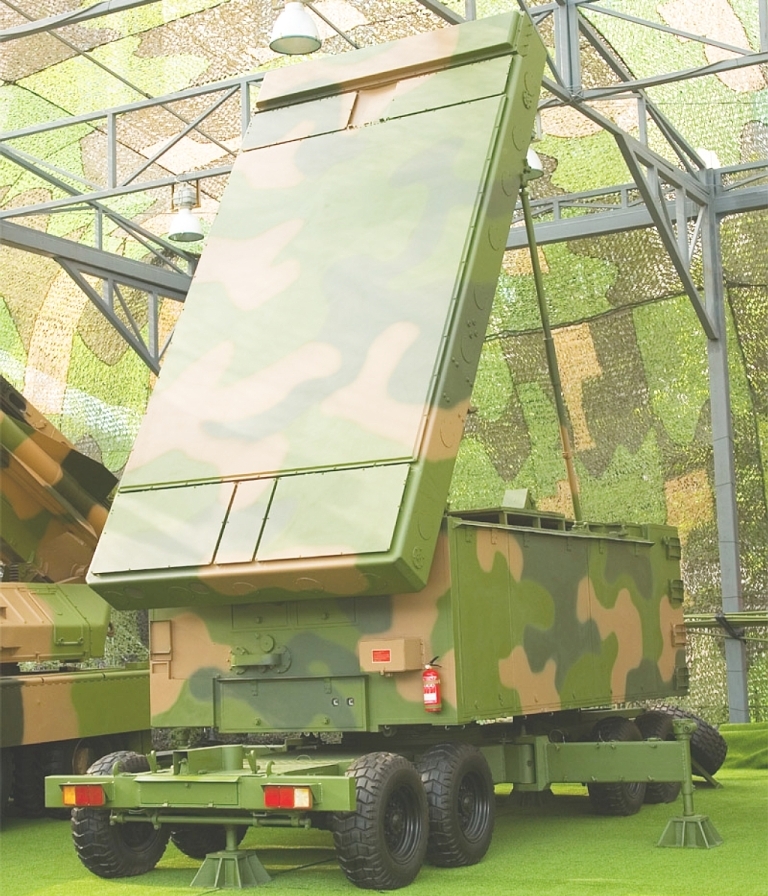 The H-200 Passive ESA (PESA) engagement
radar
used with the KS-1A SAM system is representative of the new generation
of indigenous Chinese military radars. It is modelled on the Patriot's
MPQ-53 engagement radar.
|
|||||||||||||||||||||||||||||||||||||||
|
|
|||||||||||||||||||||||||||||||||||||||
CASIC SJ-231 / KS-1A/HQ-12 Phased Array Radar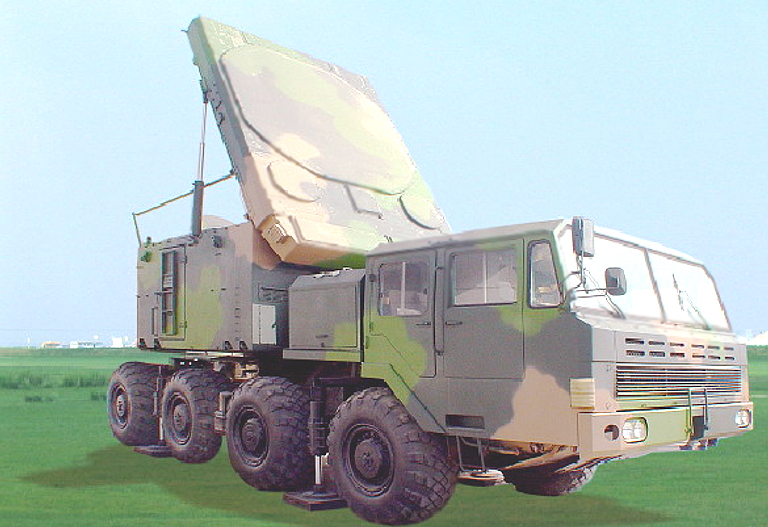 The SJ-231 is an
alternate
radar for the KS-1A/HQ-12 SAM system, based on the HT-233 PESA antenna
and cabin design. Cited performance is virtually identical to the
H-200. Unlike the towed H-200, the SJ-231 is self propelled, but unlike
the HT-233 it is split across a pair of 6 x 6 or 8 x 8 vehicles.
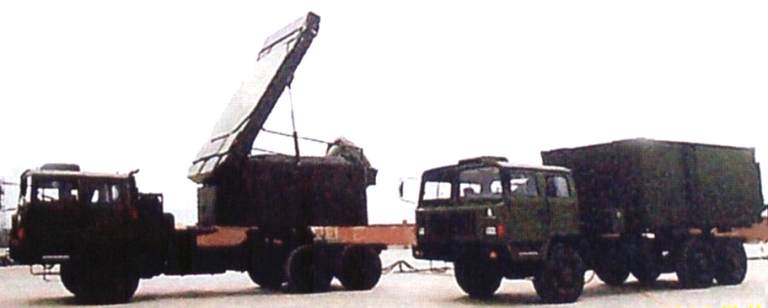 The
antenna on this radar is common to a
HT-233, but the configuration is
split across two 6 x 6 trucks.
|
|||||||||||||||||||||||||||||||||||||||
CNPIPC / CEIEC H-200 KS-1A / HQ-12 Phased Array / Triumphant Mountain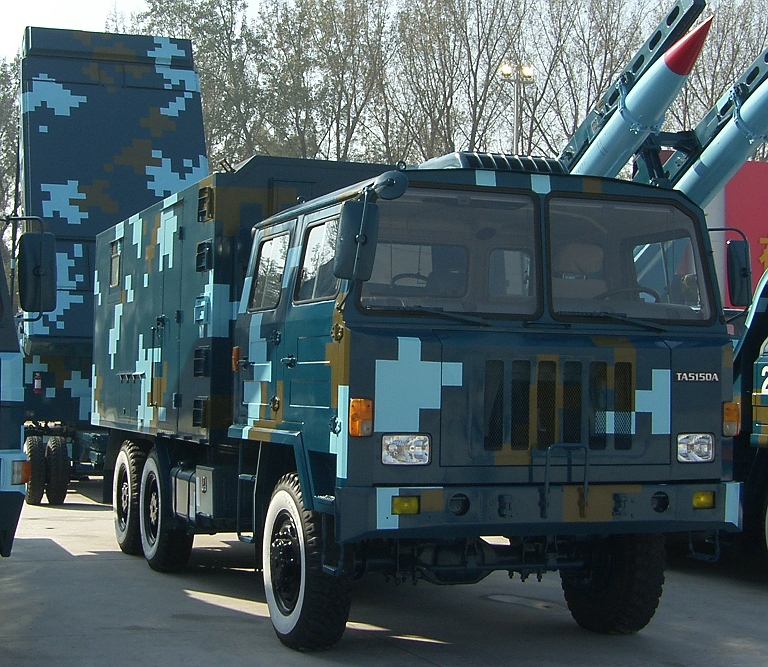 H-200 engagement radar and
KS-1A TEL. The H-200 is semi-mobile, but with further evolution could
qualify as mobile (© 2009,
Bradley Huang).
In 2000 the KS-1A was promoted as a new air defence missile, supplanting the earlier SA-2 copy known as the KS-1 (Kaishan-1, refer SJ-202). A ‘medium-to-high altitude, long-range SAM guidance station’ is how this radar is presented and it is believed to be a Chinese reverse engineered copy of the American AN/MPQ-53 Patriot radar. This being the case, the H-200 can be expected to function in G-bands, offering integrated electronic sector surveillance, target detection (TD), target tracking (TT), Identification Friend & Foe (IFF), and missile guidance (MG) functionality. The antenna face comprises surveillance, IFF, target illumination and data transmission elements, and will offer phase steered target detection over an approximate 90º sector and tracking over a somewhat wider sector, but less than 160º. Reported capability is as follows: Target detection & tracking ranges: Max detection range: ≥120km @ 8 km altitude ≥50km @ 0.1km alt Max stable tracking: ≥90km @ 8 km alt ≥45km @ 0.1km alt Target characteristics: RCS: 2m2 Max target velocity: 750m/s (2.18 Mach) Manoeuvre overload: 5.5g Tracking capacity: Accurate tracking 3 targets; Monitoring 3 targets; Guidance 6 missiles; Guidance error: ≤50m Set-up time ≤30 mins Tear-down time ≤20 mins qualifying the radar as semi-mobile. Note 1: The KS-1 missile is usually associated with the SJ-202, whereas the KS-1A is being associated with the H-200 / KS-1A phased array. Note 2: Antenna is very similar to that of BL904. A deployed example of a H-200 / KS-1A phased array radar can be seen at 43º 56’ 57.18” North, 87º 40’ 25.49” East, surrounded by six probable KS-1A missile launchers. 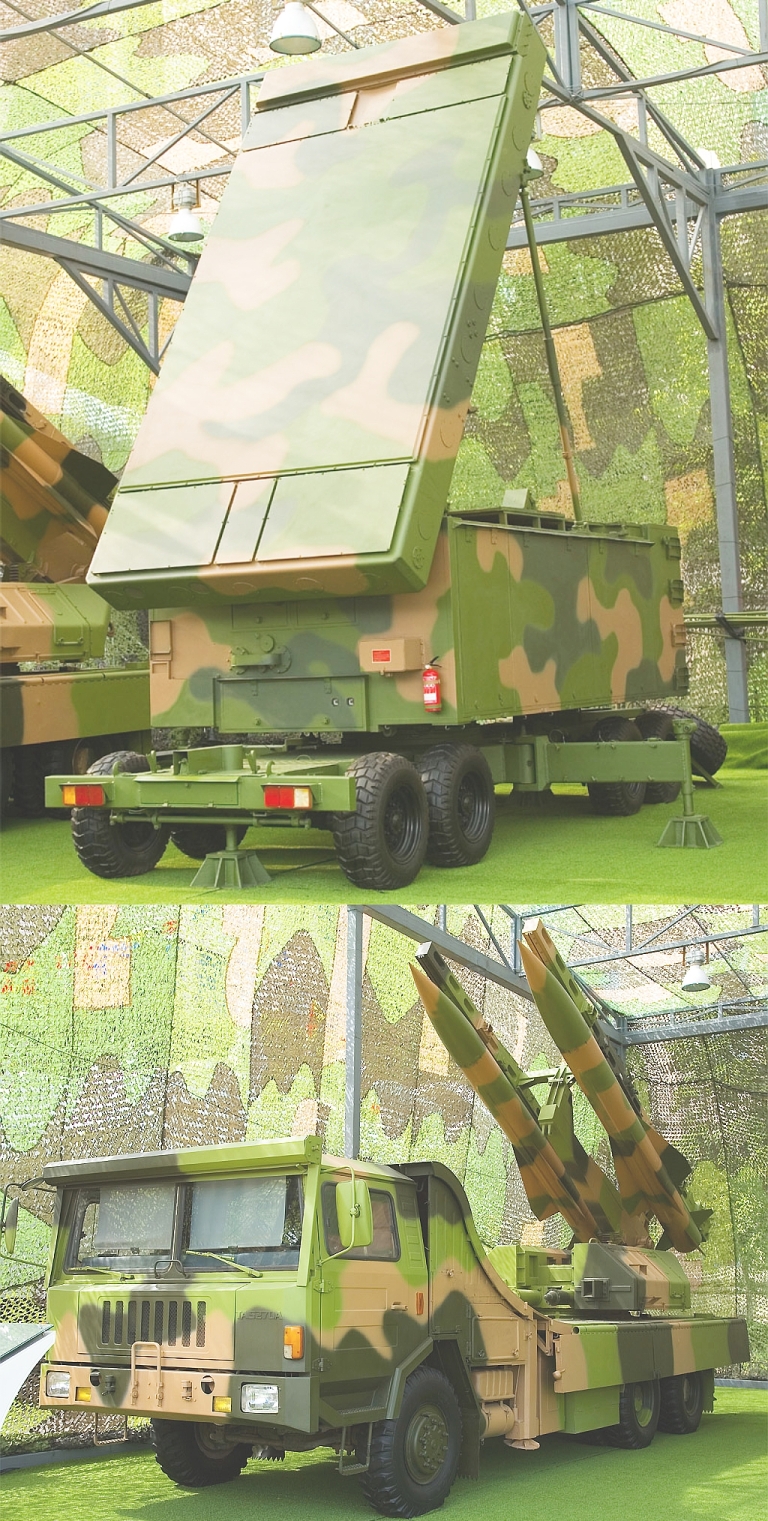 The H-200 is modelled on the MPQ-53
and
30N6E1 with a space feed arrangement, but using a simple horn rather
than lens arrangement.
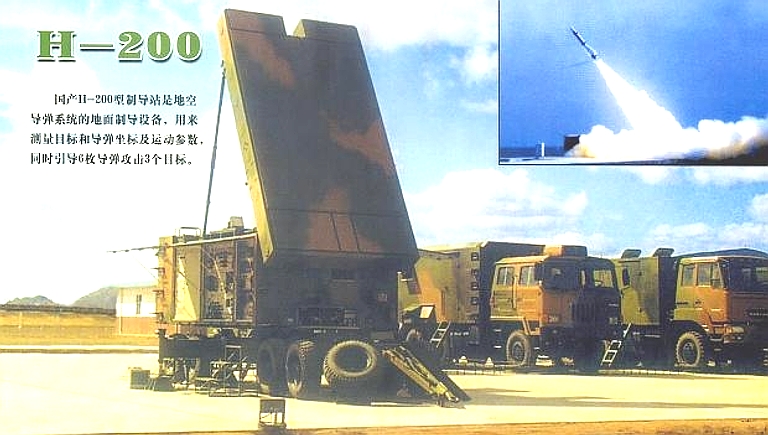 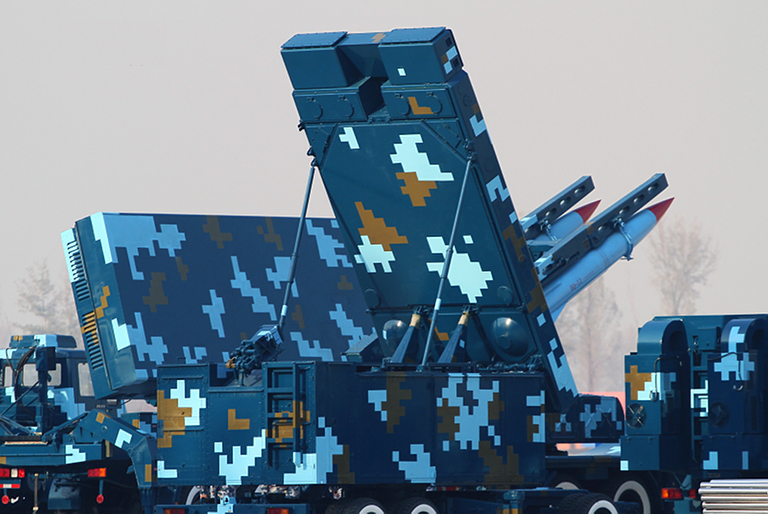 |
|||||||||||||||||||||||||||||||||||||||
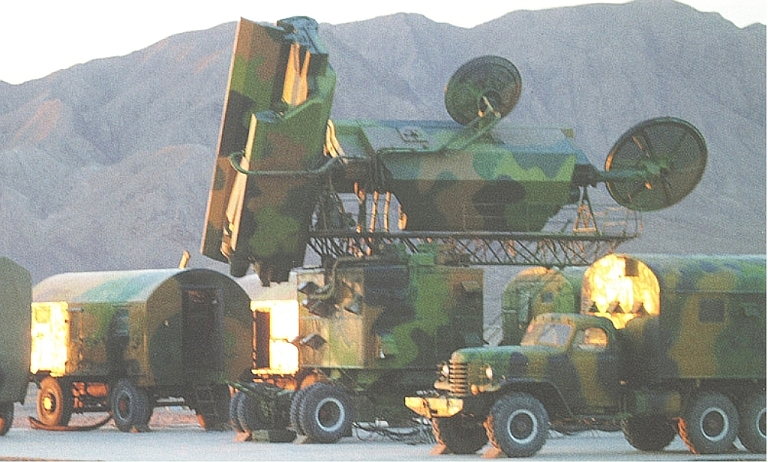 GIN SLING B is the NATO name for this engagement radar which appears to be a Chinese version of the old Soviet SNR-75 FAN SONG radar, (see also SJ-202) which is deployed with the SA-2 Guideline or KS-1 SAMs. It comprises a number of radiating elements. There are two E/F-band Lewis scanners. These are believed to be the azimuth and elevation air search elements, although this radar would not normally function in isolation, and would usually receive target prompts from any one of a variety of volumetric search radars. An F-band element is possibly used for target tracking whilst G-band elements are for missile guidance. An I-band element reportedly has a range only (RO) function for accurate range measurement whilst a D-band element may have an IFF application. ZD-2(B) is the designator given to the complete missile guidance station associated with the HQ-2B missile, whilst 2FA(B) is the radar transmitter/receiver sub-assembly. The RF and PRF/PRI value suffixes (refer book) imply their linkage during transmission. G2 may represent a second transmission source with subtly different parameters, to reduce the probability of mutual interference if they operated in close proximity. The Lewis Scan search technique combines the output of two separate assemblies that are set at 90° to each other. The RF feeds rotate independently to achieve horizontal and vertical scans respectively, over a narrow sector at a medium data rate, usually between 10 and 25 Hertz and one source has suggested a rate between 15.5 and 17 Hz This system is ageing and is not included in the CRIA 2004 list of indigenously supplied equipment (refer book). However, whilst it might still be materially supported, it is probably out of production and due for replacement. In the meantime its major attributes appear to have been retained in the visually less sophisticated SJ-202 (see separate entry), which is being promoted for export. This radar has been exported to Albania, Iran, North Korea and Pakistan. |
|||||||||||||||||||||||||||||||||||||||
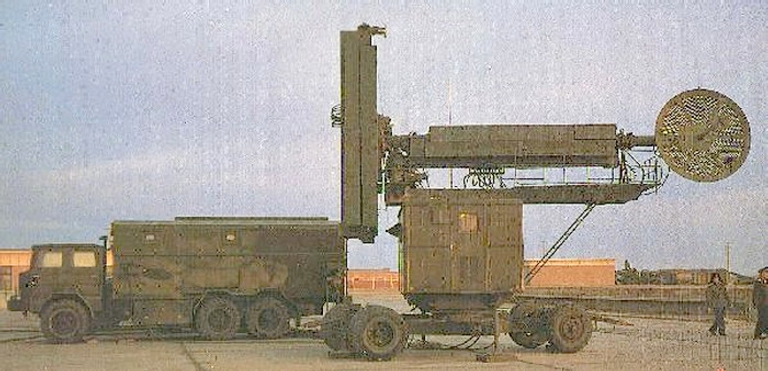 SJ-202
Gin
Sling
A.
The SJ-202 is a fire control
radar and is reported by Taiwan to be associated with the KAISHAN-1
(KS-1) SAM, although is may also be deployed for use with the HongQi-2
(HQ-2B/J) and SA-2 SAM detachments, where the latter still exist.
It appears to be an indigenous development of the system known generically to NATO as GIN SLING (see also separate entry for 2FA(B) / GIN SLING B), out of the Russian FAN SONG system to which it has very similar physical attributes and, therefore may exhibit similar transmission parameters, particularly as it appears to deploy identical LEWIS scan tracking antennas in both the horizontal and vertical planes. In this respect, although variously reported so to be, it is not a phased-array radar. The Lewis scanners are anticipated to function in the 10~25 Hertz range, and other parameters may be similar to those of GIN SLING B. 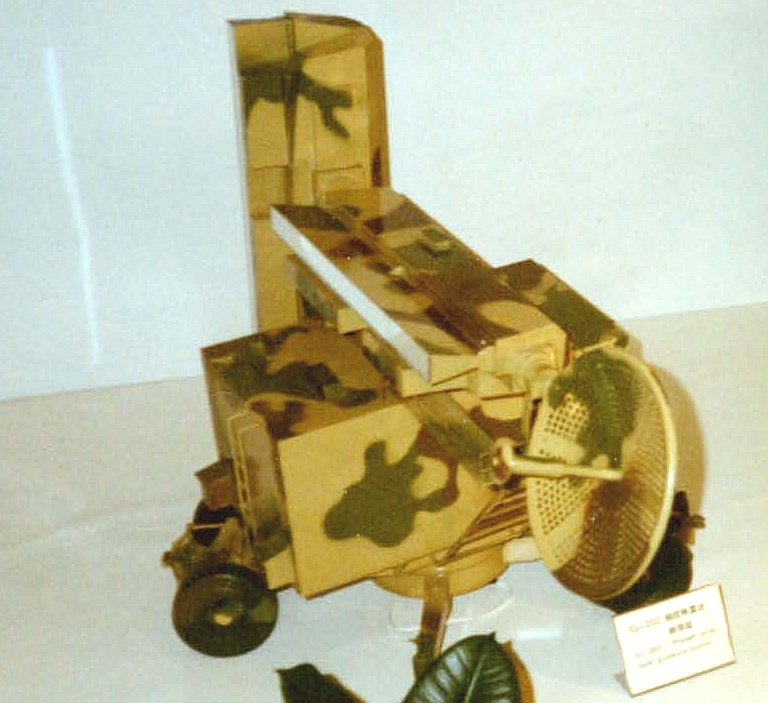 A 2004 display model of the SJ-202 Gin Sling A. |
|||||||||||||||||||||||||||||||||||||||
Type 341 /
H/LJP-341 RICE LAMP / Type 342/342C FOG LAMP /
ZL-1B SD1/A 723
|
|||||||||||||||||||||||||||||||||||||||
| Type 345 [Castor 2J/C] Specifications |
|
| Operating
Band
[MHz] |
15,700
~
17,700 |
| PRF [pps] | 3,550
~
3,650 7,150 ~ 7,250 |
| PRI
[μsec] |
273.9
~
281.7 137.9 ~ 139.8 |
| PD
[μsec] |
7.4
~
7.6 |
| Angle
Tracking |
Monopulse |
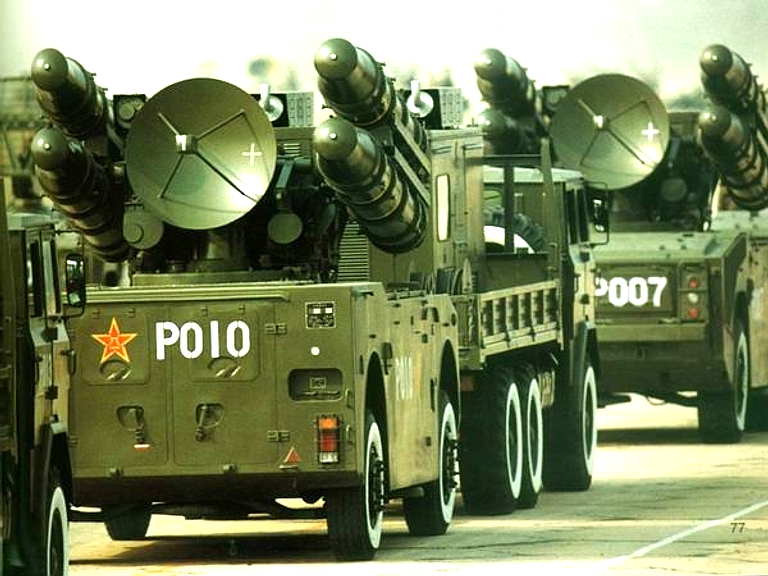
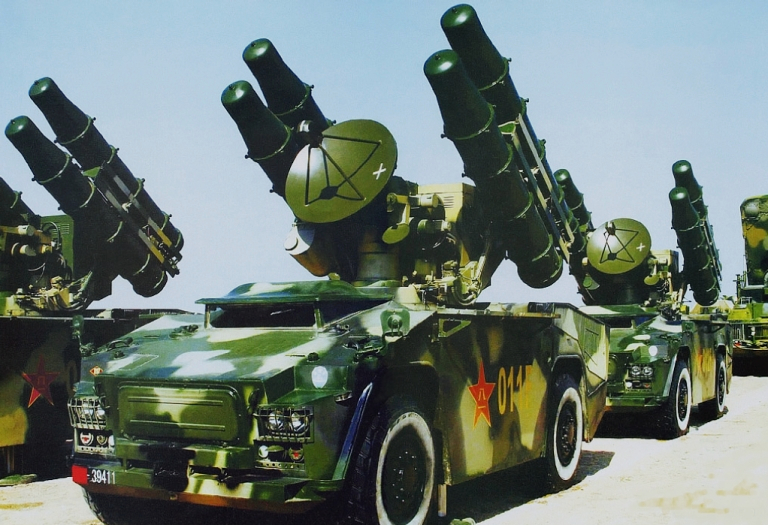
HQ-7FS/FM-80 engagement radar on 4 x 4 TELAR.
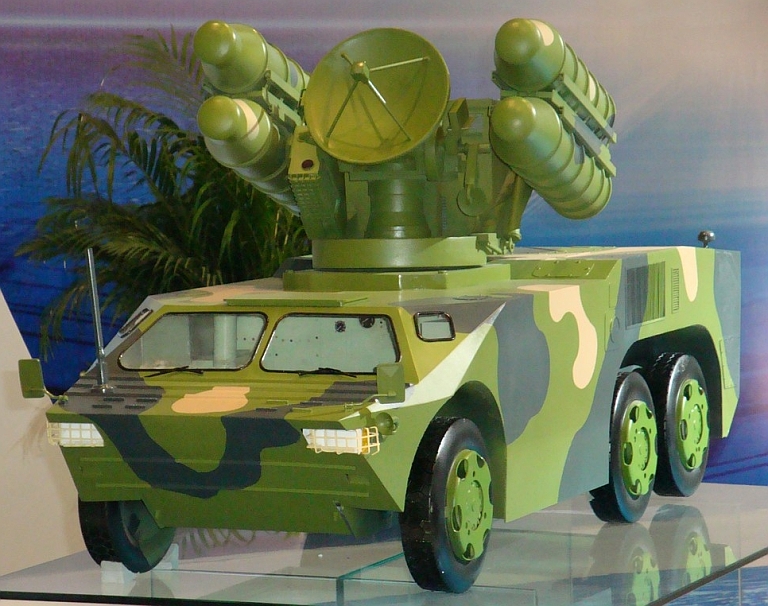
HQ-7FS/FM-90 engagement radar on 6 x 6 TELAR (image © 2009, Zhenguan Studio).
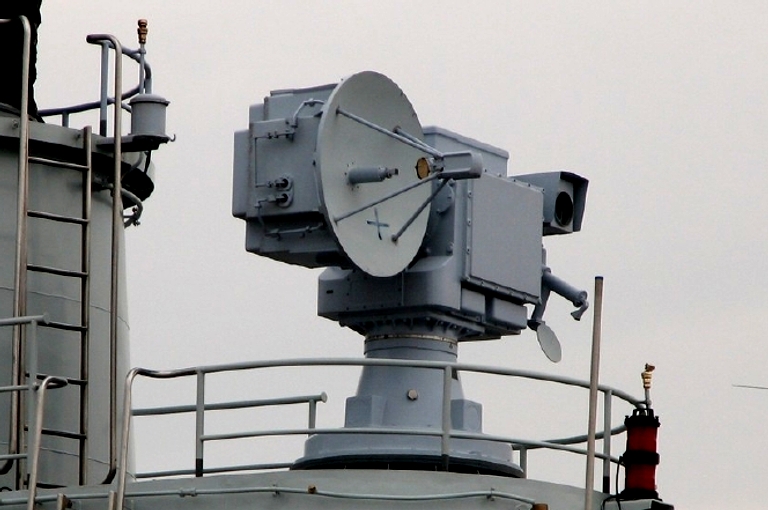
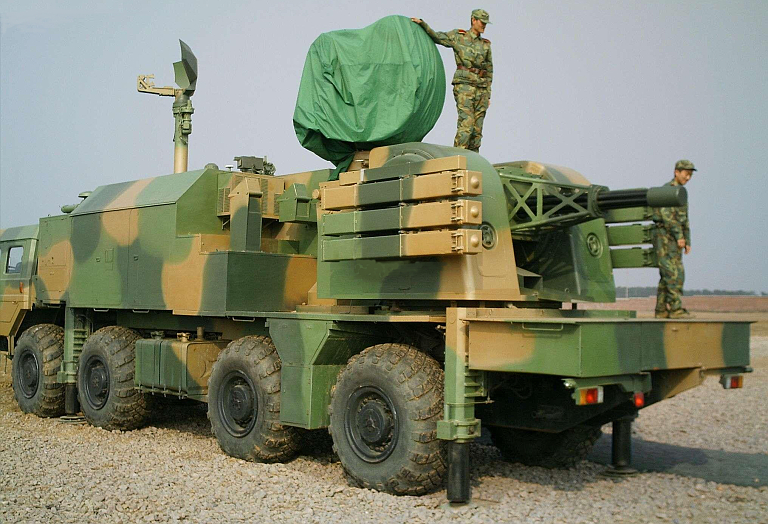
NORINCO have confirmed that the tracking radar operates in J-band, estimated between 15.7 and 17.3 GHz, with a maximum cited range of 9 km. This would imply a maximum PRF of around 16,000 pps. There is also a coupled TV and IR tracker system on the weapon, that was used for acceptance trials, which were apparently successful. The acquisition radar functions in I-band, estimated between 8.8 and 9.7 GHz.
Following the trials, in an original format vehicle, it is now being offered for export.
According to Christopher F. Foss in JDW 25Nov09 p27; the gun is a Type 730B 30mm 7-barrel Gatling with a max rate of fire of 4,200 rounds/min, over an effective range of 2.5 ~ 3.5 km. The weapon is loaded with 1,000 rounds, enough, apparently, for about 48 potential target engagements. As reported originally in the Chinese radars text, the gun is capable of firing armour-piercing discarding sabot (APDS), high explosive incendiary (HEI) and target practice (TP) rounds.
The limitation of the existing LD-2000 design is in its acquisition radar, which is not suitable for high speed low radar cross section targets, especially flown along steep trajectories. This precludes the use of the current LD-2000 configuration in C-RAM and C-PGM roles. The TR-47 series tracking radar has been used for naval shipboard defence applications and is claimed to be effective against Mach 2 low signature sea skimming threats, making it viable for land based C-RAM and C-PGM roles. The principal adaptation required to make the LD-2000 a highly capable C-RAM/C-PGM system is integration with a suitable acquisition radar design, such as the SLC-2 or newer Type 704 series counter-battery radars, for a narrower C-PGM role an existing air defence phased array such as the H-200 would be suitable.
TR-47G Engagement Radar
Export Desig: TR47G
Other Desigs: TR47C, Type 47G
Supplier: YMEIRI
Parametrics:
RF (MHz) 8,800 ~ 9,600
RF Agility 700 MHz
PRF (pps) -
PRI (μsecs) -
PD (μsecs) 0.3 ~ 0.4
Modulation Pulsed
ST Monopulse - Circular -
Antenna:
Beamwidth (H & V) 2º
Gain ≥ 37dB
Tracking accuracy:
Bearing ≤ 1mrad
Elevation ≤ 1 mrad
Range ≤ 5 m
Transmitter:
Peak power 120-150 kW
Receiver:
Noise Factor ≤9 dB
System reaction time ≤ 3s
MTI improvement factor ≥ 25dB
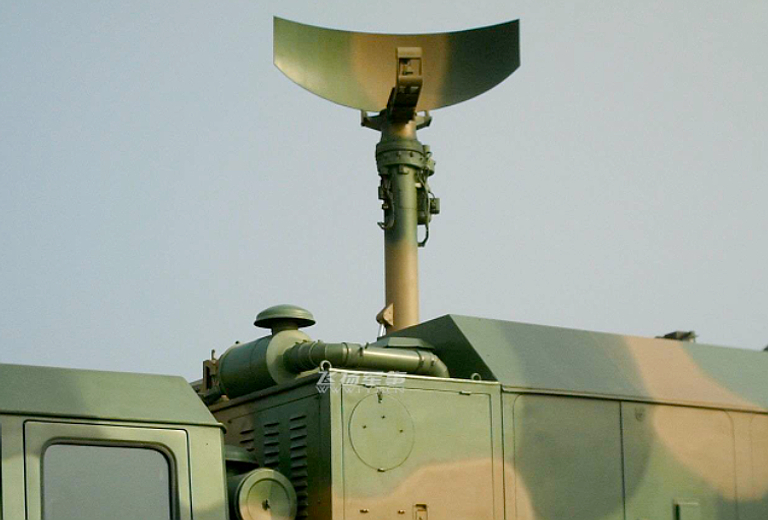
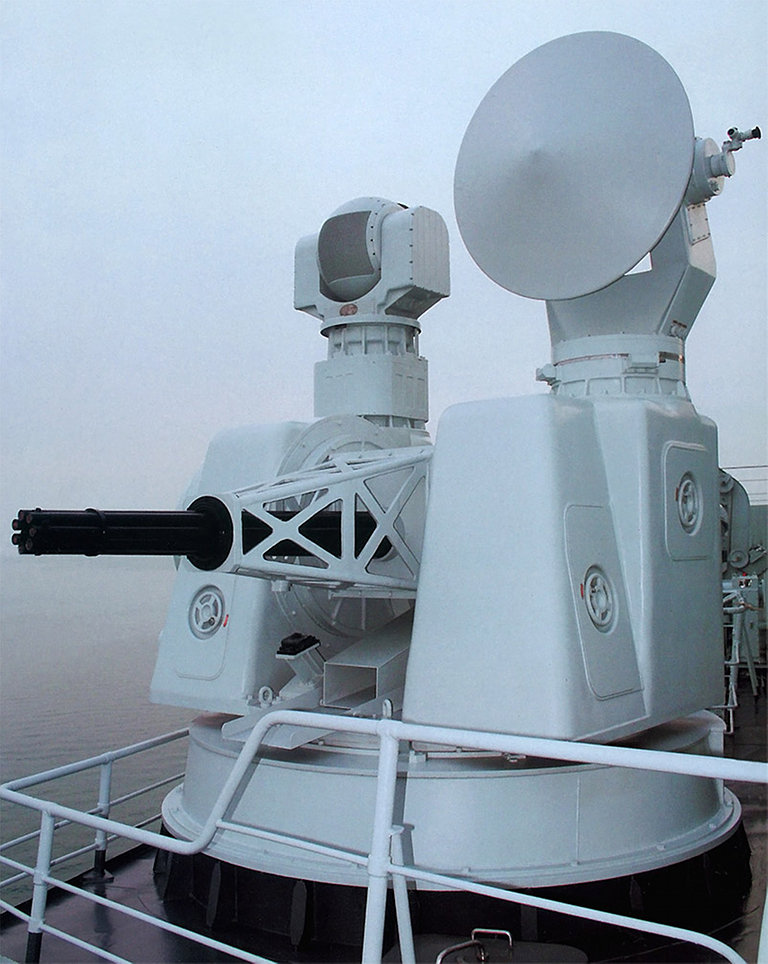
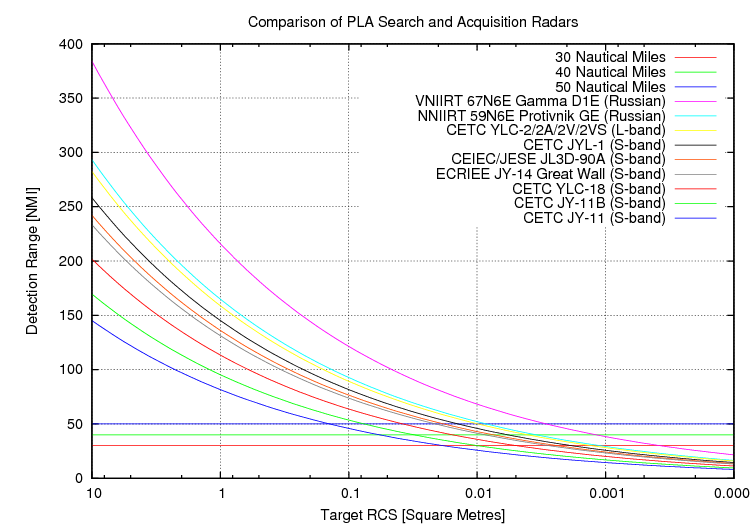
Comparison of PLA search and acquisition radar performance. The Russian Protivnik GE and Gamma DE are included for reference (C. Kopp)
NRIET/CEIEC/CETC YLC-2/YLC-2A/YLC-2V High Guard 3D Long Range Surveillance Radar
Little is known about this radar except that five YLC-2 radars were handed over to the Pakistani Air Force (PAF) at Faisal Airbase on 15th June 2003, and probably two more in 2006, to be used in support of the PAF air defence network1, where it was reported to be a high-powered, solid-state, long-range 3D air surveillance radar, similarly reported by its manufacturer Nanjing Research Institute of Electronic Technology (NRIET), without reference to having a phased array in either case.
Although China reporters2 have often claimed that frequency-scanning radars are phased arrays, recently provided data suggests that the YLC-2 is actually an active phased array.3
The antenna array has 54 horizontal elements, each fed by a 2.0 kW (peak, at 8% duty cycle) T/R module that is reported to have improved upon the earlier design of the AN/TPS-59 and GE-592 radars of which it appears to be a copy. The main antenna is topped by an IFF/MSSR array.
The system is said to have a detection range of 330km, which would suggest a peak PRF of around 455pps and operational PRF of about 300pps. It is reported to have a variety of electronic counter-countermeasures (ECCMs), to enable survival in a hostile electro-magnetic environment.
There are two other versions, the YLC-2A and YLC-2V (see) but both employ smaller, more compact antenna arrays and have been declared to function in E/F-band.
Wikipedia claims the following unverifiable specification:
Detection range: 330 km
Range accuracy: 200 m
Range resolution: 300 m
Azimuth: 0º ~ 360º
Elevation: 0.5º ~ 20º
Height accuracy: 400m @ 200 km
750m @ 300 km
Antenna aperture: 7m x 9 m
Sidelobe level: -35 dB
MTI improvement factor: 44 dB
Peak power: 85 kW
Average power: 5.5 kW
A single report suggests an instrumental range of 550km, which would require a minimum PRF of about 275pps whilst a range resolution of 300m would indicated a minimum (processed) PD of 1µs.
One source has referred to a YLC-2 radar as the ‘San Zuobiao remote warning radar’. Subject to confirmation, it is assumed that San Zuobiao is the location of a YLC-2 installation.
| PLA Desig: | YLC-2 | |
| Export Desig: | ||
| Other Desigs: | High Guard | |
| Supplier: |
NRIET / CEIEC / CETC | |
| Parametrics: | ||
| RF (MHz) | 1,240 ~ 1,400 | |
| PRF (pps) | ~275 | |
| PRI (µsecs) | ~363 | |
| PD (µsecs) | ~1.0 | |
| Modulation | Pulsed | |
| ST | Circular | |
| SP (sec / Hz) | secs | |
2 http://www.sinodefence.com/electronics/radar/ylc2.asp
3 Chen Zhencheng,1996 Beijing Radar Conference (pp.171-174).
4 Most Chinese radar reporting sources tend to call frequency scanning (Frescan) radars ‘phased array radars’, which from a strict purist viewpoint, they are not. China only has few active phased array systems of which Type 346, installed on Type 052C Luyang II-class destroyers is a good example. Most of China’s ‘phased arrays’ are in fact Frescan systems, mechanically scanning in azimuth and frequency scanning in elevation. A Chinese commentator in Hong Kong stated that it is a far less expensive solution [than an active phased array] but still produces good results - a phrase previously voiced by Russian commentators when comparing active and passive phased arrays.
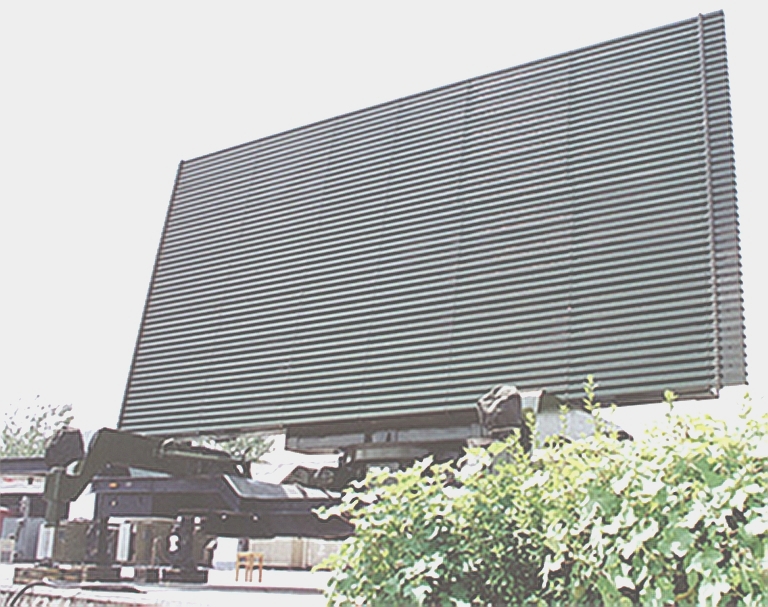
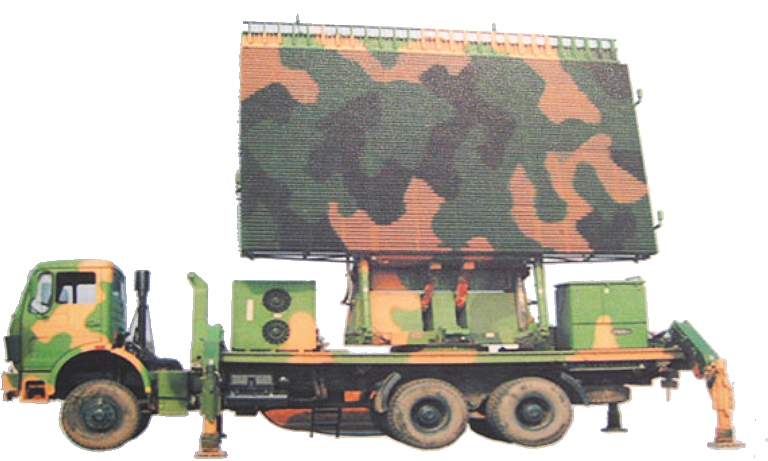
Self propelled YLC-2V variant deployed and on the move.
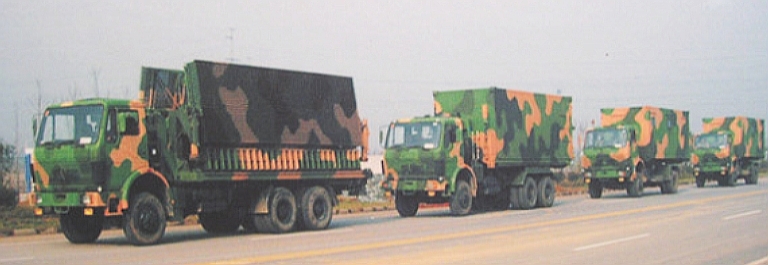
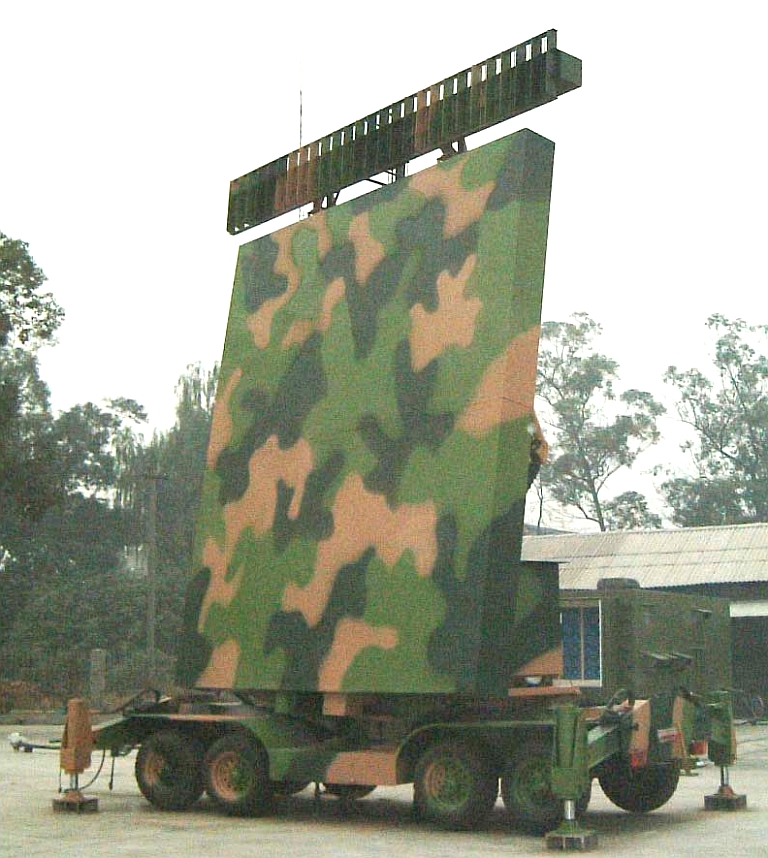
This radar is carried in the 2004 CRIA listing of Chinese indigenous products.
This is a fully coherent, 3D radar with a low side-lobe, planar, phased array antenna.
The radar may be used for civil and friendly air traffic management, detection of hostile aircraft and, as in the illustration, it may have an IFF sub-system integrated to determine the friendliness of targets in flight.
Recent
information (2004) states that the JL3D-90A employs a radio frequency
(RF) agile transmitter with a klystron amplifier chain and a low-noise
linear receiver using digital pulse compression techniques to achieve
long-range detection with good target discrimination. Adaptive digital
signal processing is employed with comprehensive BITE.
The receiver’s dynamic range is given two different value in two brochures, one each from JESE and CEIEC
Monopulse sum/difference height measurement is employed with automatic target extraction and adaptive signal processing.
Target processing capacity is 100 tracks for every antenna scan (10secs).
The antenna cover diagram for a probability of detection of 80% against a radar cross section of 2m2 is illustrated, whilst the processing and display cabinets are shown below.
Target detection data:
Range: 300km
Altitude: 20,000m
Range accuracy: 150m
Altitude accuracy: 500m
Azimuth accuracy: 0.25°
Range resolution: 90m
Azimuth resolution: 1.5º
The antenna:
Dimensions: 5.2m x 5.4m
Elevation cover 0.5º -20º
Gain: 38.5dB
Horizontal beamwidth: 1.5º
Vertical beamwidth: 1.5°
Near axis side-lobe level -35dB
Far axis side-lobe level -45dB
Peak power output: 700kW.
Receiver:
Noise figure: ≤2dB
Dynamic range: 90dB/110dB
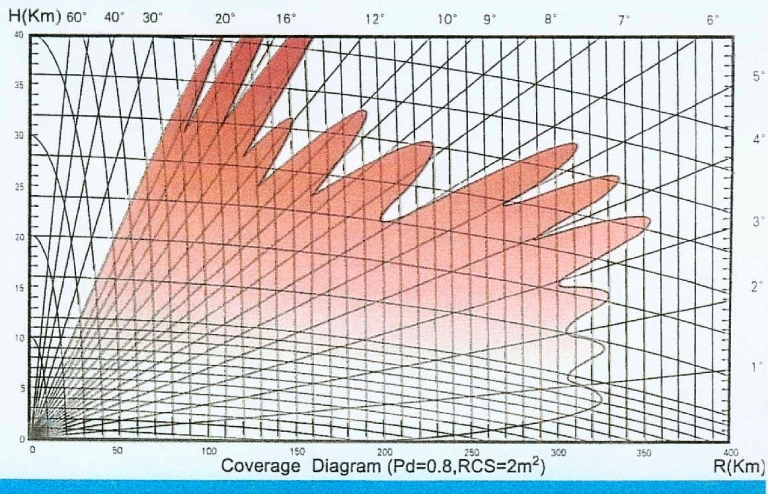
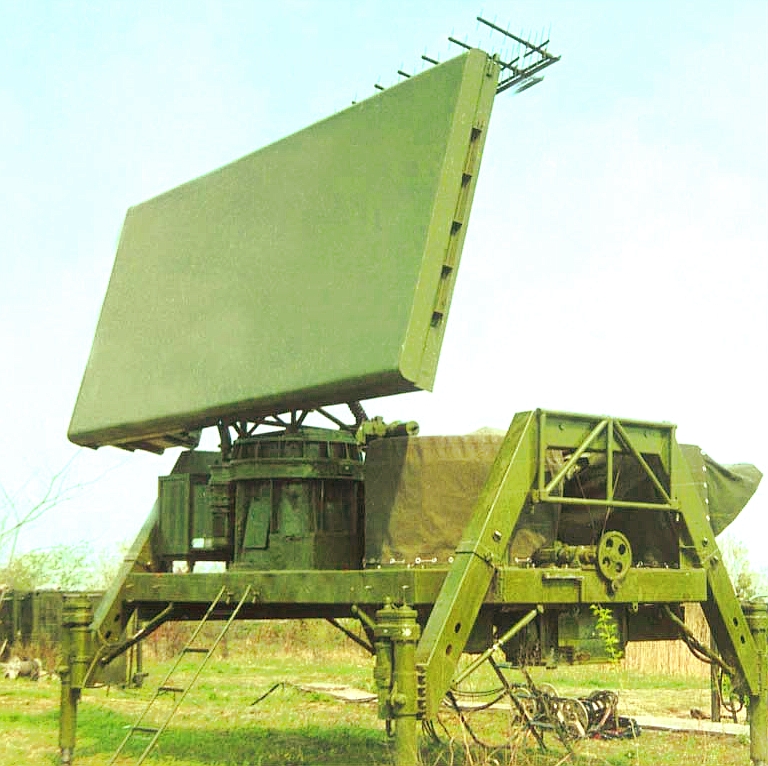
A modern, highly mobile F-band radar with an integrated D-band IFF sub-system designed as a low-to-medium altitude 3D surveillance gap-filling system, capable of military air traffic control (ATC).
This radar was first declared (as HUNTER1) at the International Radar Symposium in Munich 1998, where it was stated to be a highly mobile, solid-state, frequency-scanning, target indication radar. For mobility it locates very quickly piggy-back fashion on a flat-back 4x4 truck.
The JY-11 is a 3D radar, mechanically scanned in azimuth and frequency scanned in elevation where it has five groups of beams: one long range and four medium range groups. The five groups forming a total of 14 electronically scanned beams providing 30º of vertical cover.
Facilities and capabilities include a narrow-beam, low sidelobe antenna with dual, slow-wave structure enabling the radar to operate over two sub-frequency bands separated by 100 MHz, which overcomes the disadvantage of weak anti-active jamming capability in a single band.
Digital pulse compression with a relatively low power output, across a large dynamic range, is achieved by a fully coherent highly reliable frequency synthesizer.
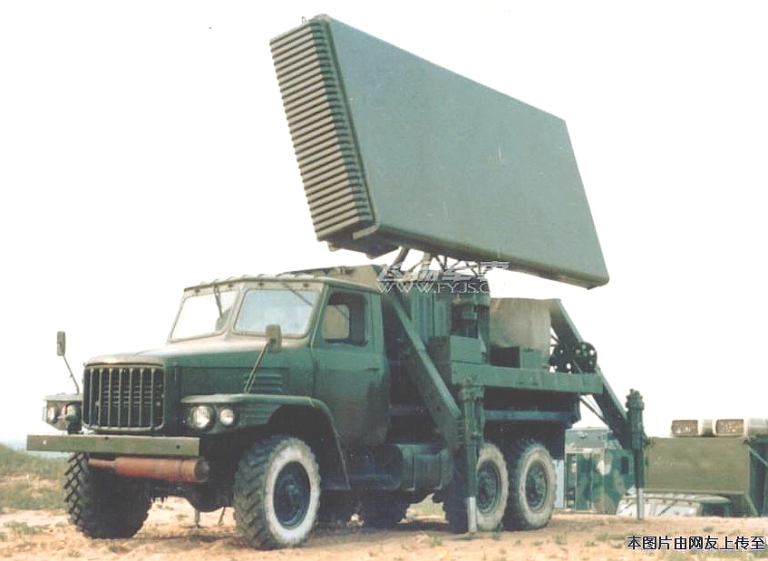
There is a JY-11B but it appears to have significantly newer attributes. This radar is not carried in the 2004 CRIA listing of Chinese indigenous products.
It employs ‘reconfigurable’ transmission beams and Digital Beam Forming (DBF) for reception to provide low-altitude and good sea-surface detection, with modern processing techniques including AMTI and pulse Doppler sampling.
Unlike the forgoing JY-11, this is not a dismountable system but the antenna can be raised on a hydraulically controlled tower to improve the system’s low altitude coverage, very similar in concept and design to the German TRM-S system, or ByeloRussian Vostok E.
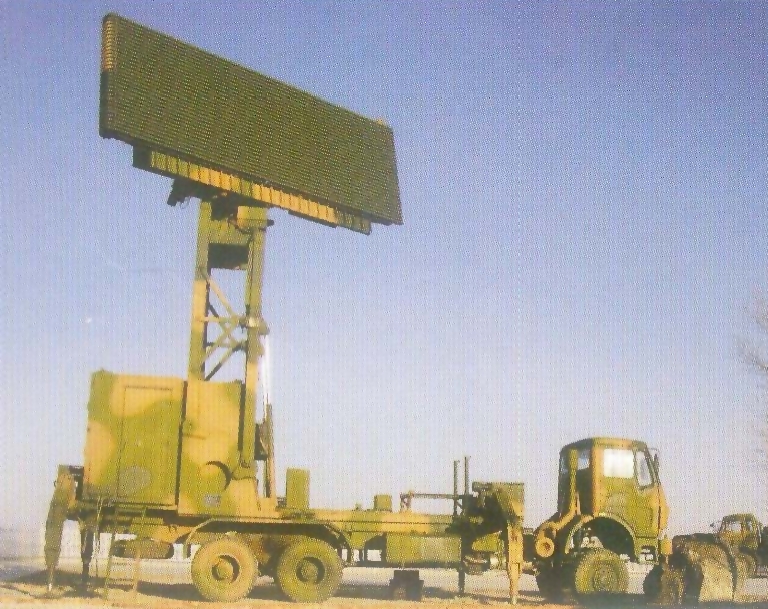
Self-propelled
JY-11B
deployed.

JY-11 Specifications: (Pd=80, Pf=10-6, RCS 2m2)
| Band: |
2.7 - 3.4 GHz |
| Detection
range: Detection altitude: Elevation: |
>180km 15,000 m 0º ~ 30º |
| Azimuth: | 0º ~ 360º |
| Resolution: | |
| Range: Azimuth: |
200m 2.5º |
| Other Data: | |
| Peak power output: First sidelobe level: | 13.5 kW -35 dB |
| MTBF: | 800 hrs |
| MTTR: | 0.5 hrs |
JY-11B Specifications: (Pd=80, Pf=10-6, RCS 2m2)
| Target detection data: Range: Altitude: Elevation: |
210km 12,000m 0º ~ 35º |
|---|---|
| Azimuth | 0º ~ 360º |
| Range accuracy: Azimuth accuracy: Height accuracy: (≤100km) |
50m 0.3° 500m |
| Range resolution: Azimuth resolution: |
100m 1.8º |
| MTBCF: MTTR: |
1,000 hrs 0.5 hrs |
Deployment: 10
mins
/
4
persons
Withdrawal: 10 mins / 4
persons
Transportability: Road,
rail, sea or air
ECRIEE / CETC JY-29 / LSS-1 Low Altitude 2D Air Defence Radar
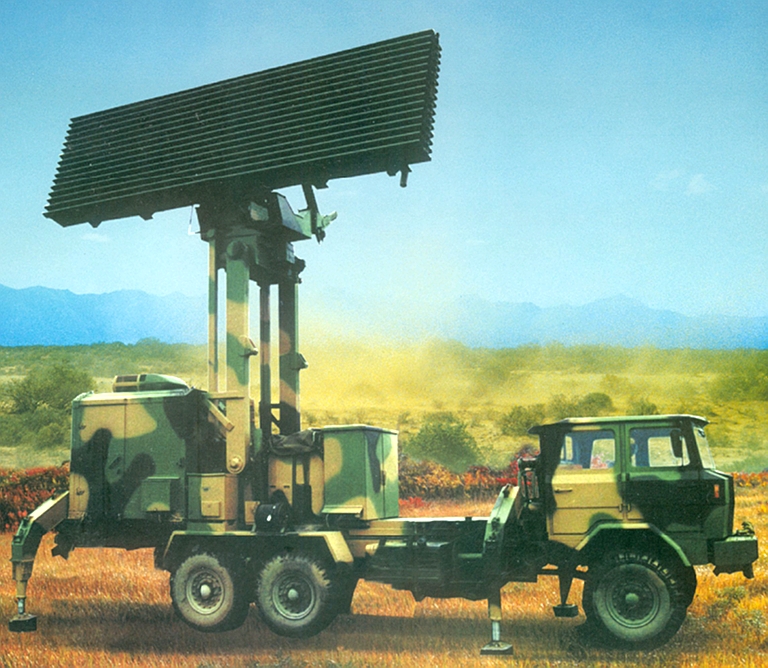
LSS-1 is listed by CRIA as a current indigenous product manufactured by ECRIEE and was presented in model form at CIDEX, the Beijing Defence Exhibition, in May 2004.
Since the original notification of production in 2004, the system’s reported measurement accuracy and resolution have been halved.
The first reference to this family of radars was as the JY-29, in a 2001 IEEE conference publication. The Type 120 radar, hosted on a North-Benz 6 x 6 military truck, appears to be a direct evolution of the LSS-1 design, for use by PLA air defence units.
Coverage: (Pd= 80%, Pfaa=10-6, SW1, σ = 2 m2)
Azimuth 0º~360º
Elevation: 0º~30º
Instrumented range: 250 km
Search range: 200 km
Height: 12,000 m
Target capacity: ≥72 tracks
Given a detection range of 180km would suggest maximum PRF in the order of 830pps.
Measurement Accuracy: (rms)
Range: 100 m
Azimuth: 0.5º
Target Resolution: (Pd=0.5)
Range: 300 m
Azimuth: 2.0º
MTBCF: ≥ 800 hrs
MTTR: ≤ 30 mins
Deployment: 5 mins by 2 persons
Withdrawal: 5 mins by 2 persons
Startup time: 30 seconds
Transport units: 2 x 6-wheeled vehicles
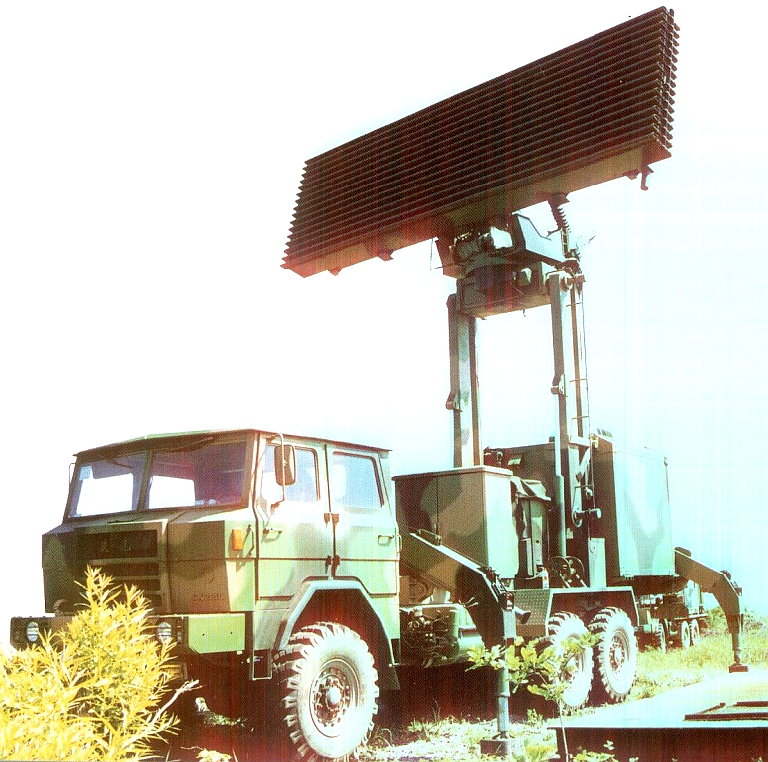
Type 120 / K/LLQ120 Self Propelled Low Altitude Acquisition Radar
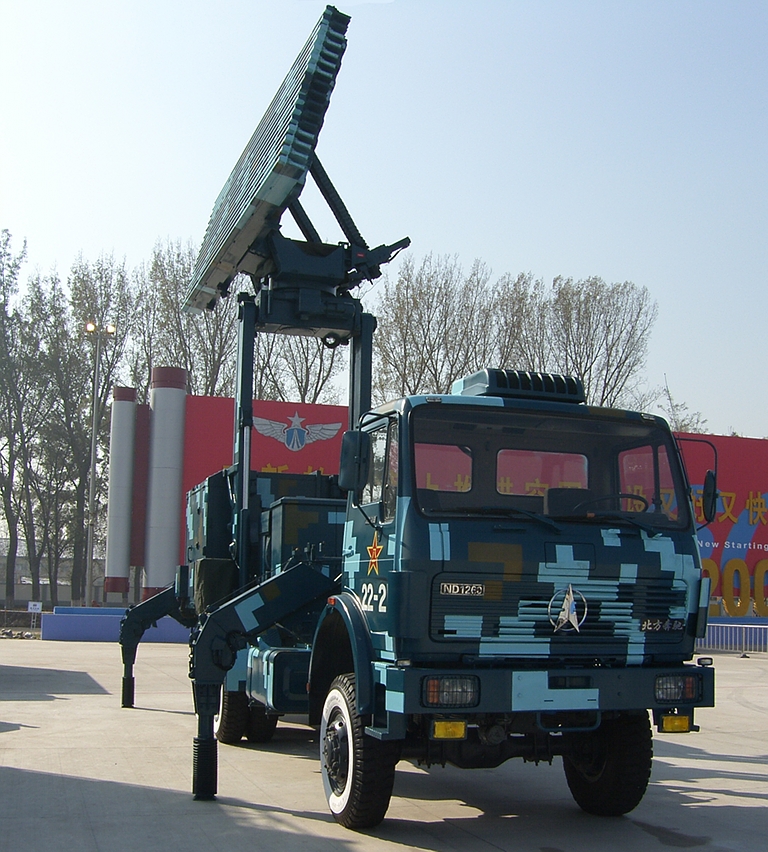
ECRIEE / CETC JYL-1 Long-range 3D Air Defence Radar
Self-propelled
variant
of
the
JYL-1
(ABN).
The JYL-1 radar is carried in the 2004 CRIA listing of Chinese indigenous products.
The JYL-1 is a long-range 3D surveillance radar typical of those assets that might be found in a modern air defence network.
It functions in the E/F-band region and might be used as either a military or commercial asset for air traffic control and management purposes.
Coverage:
(Pd=80%, Pf=10-6, SW1, RCS=2m2)
Azimuth
0º
~
360º
Elevation: 0º ~ 25º
Search range; 320km
Height: 25,000m
Measurement
Accuracy
(rms):
Range: 100m
Azimuth: 0.3º
Height: 600m @ 200km
Azimuth: 0.3º
Resolution:
Range: 200m
Azimuth 1.5º
Reliability:
MTBF: ≥ 800hrs
MTTR: ≤ 0.5 hrs
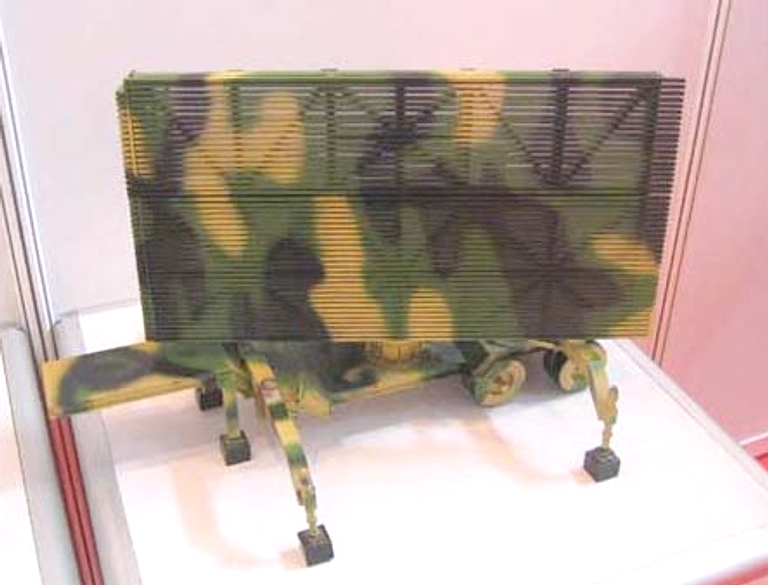
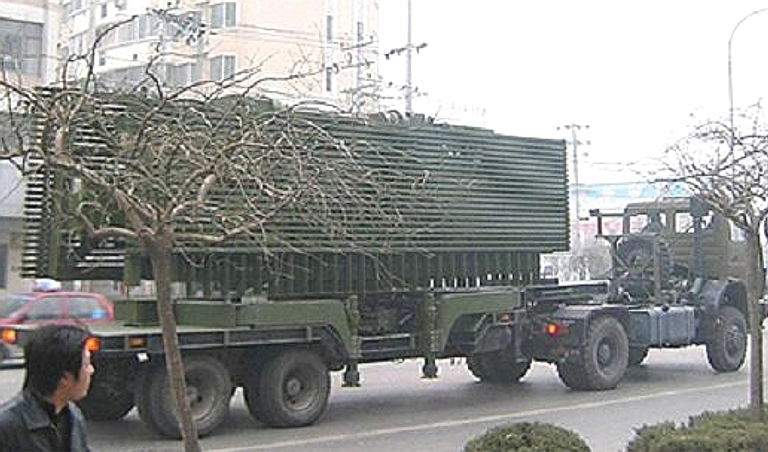
The picture above is interesting because, although captioned as a JYL-1, most pictures show this radar to be mounted on a flat-bed truck, like that shown in the title image, but this is a demountable version, more akin to the JY-11 series .
It takes approximately 1 hour by 8 persons to setup the system and a similar time to dismantle it.
Three vehicles form the system convoy. The latest picture made available by CETC confirms that the antenna is demountable.
CETC JY-27 Wide Mat VHF Band Long Range 2D Surveillance Radar
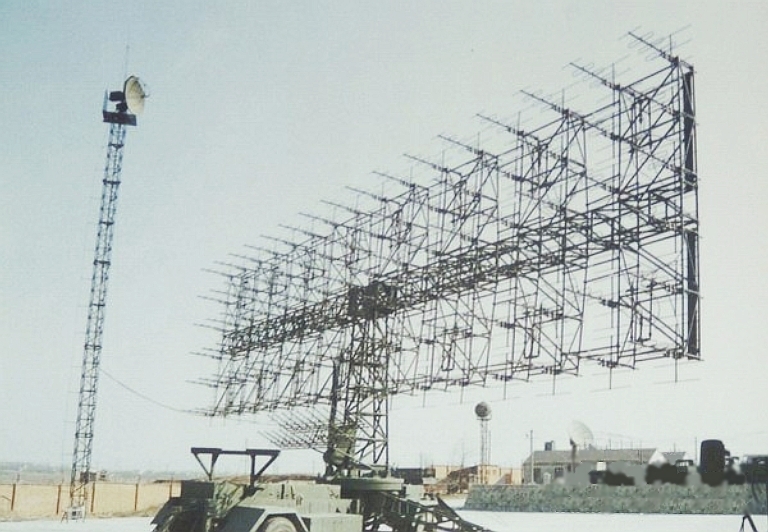
NRIET / CEIEC / CETC YLC-4 2D Long Range Surveillance Radar
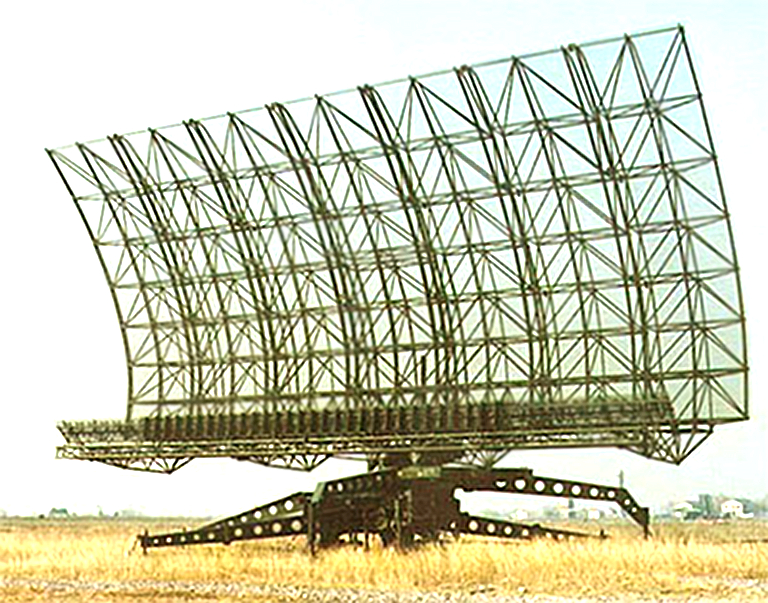
CETC YLC-8/8A VHF Band Long Range 2D Surveillance Radar
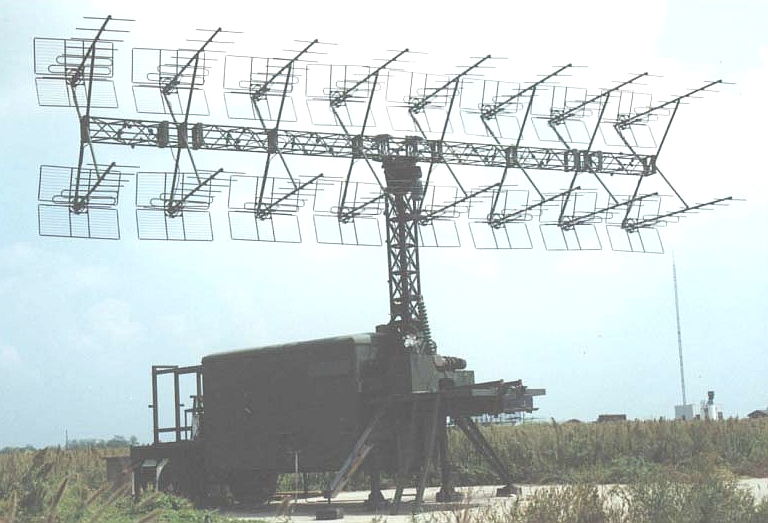
ECRIEE JY-14 / Great Wall Tactical 3D Surveillance Radar
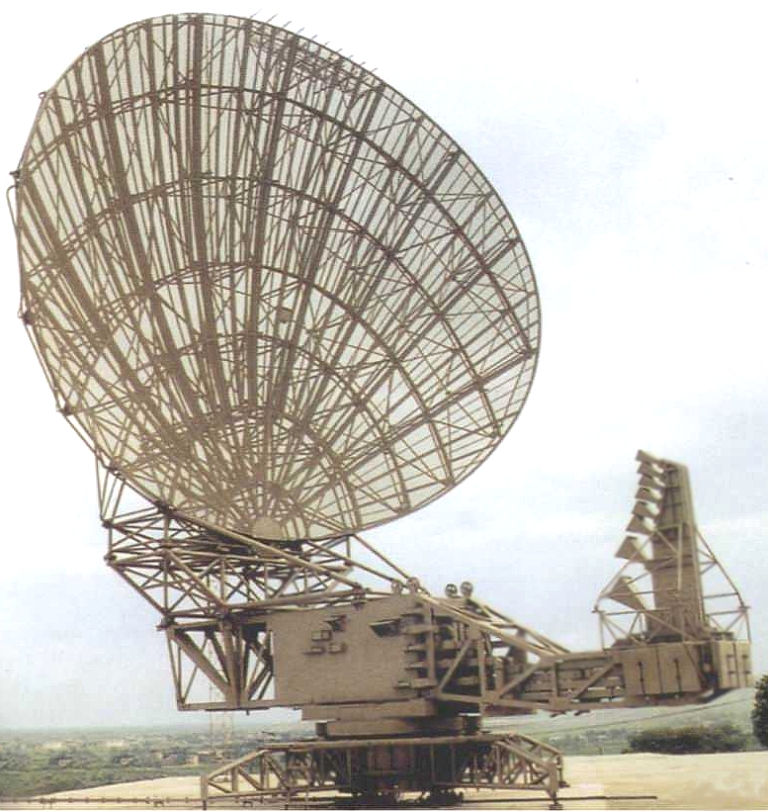
This is a medium-to long-range tactical 3D surveillance radar the primary function of which is air defence, and it is expected to be deployed in regional air defence networks.
It has 8 RF feeds, six in E/F-band and two in D-band, the latter two giving good height cover where the lowest may also be used for an IFF facility. Reported parameters are:
Coverage: (Pd=0.9, Pfa=10-6, SW1, σ = 3m2)
Azimuth 360º
Elevation: 0º~20º
Search range; 320km
Height: 25,000m
Target capacity: ≥72 tracks
Antenna:
Beams: 8 vertically stacked / 1st sidelobe -30db
Detection Accuracy (rms):
Range: 90m
Azimuth: 0.2º
Height: 400m @ 200km
Target Resolution:
Range: 300m
Azimuth 0.9º
Elevation 1.0º
Reliability:
MTBF: ≥4150hrs
MTTR: ≤30mins
MTI improvement 40dB
System noise figure 5.5dB
IF bandwidth 450Hz
This radar employs a number of modern technologies including a low-sidelobe antenna, pulse compression, self-adaptive moving target indication (AMTI), with a peak envelope power (PEP) of approximately 1MW.
JY-14 is reported to have a range of anti jamming facilities, to ensure normal operation in the most severe of electronic warfare (EW) environments.
RF agility range is stated to be 15%, which suggests about 450MHz in the highest RF range listed. There is a selection of 30 RFs within this range available for diversity or agility operations, which suggests repetitive fixed frequency hopping in the latter case.
At least one source states that the frequency diversity interval is 150MHz, which might confirm the use of the two lower frequency sub-bands.
Notes:
Outside of mainland China, and arguably even within it, the lowest RF band shown is considered unlikely (in peacetime) as it is no longer allocated for radar operations (refer book).
On 22nd October 2001, China Reform Monitor No. 410 reported that a JY-14 emitter had been detected in Iran (by electronic intercept) close to the Afghanistan border.
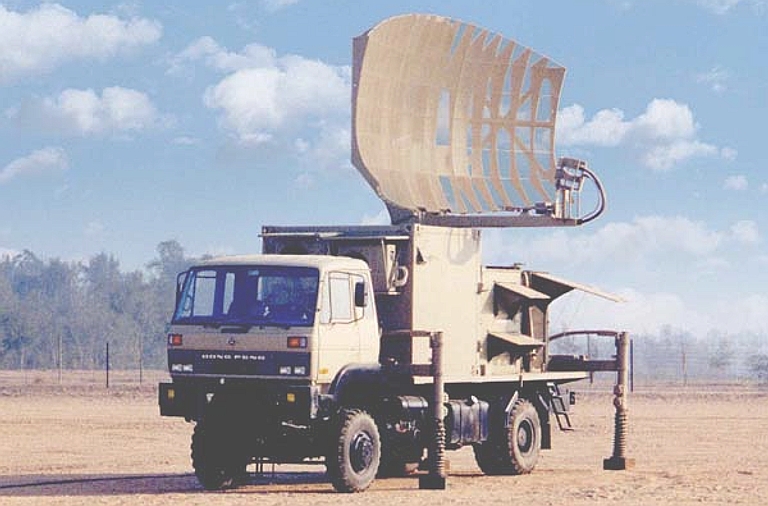
This radar was initially reported at the Chinese International Conference on Radar, held in Beijing in 1996, where a paper described it as a highly mobile, solid-state, three-coordinate, medium-range surveillance radar, developed by NRIET. Since then it has been consistently reported as a 2D radar.
The YLC-6 is a demountable radar that incorporates a range of modern technologies including an advanced MTD processor to enhance its tactical performance for both military and civil applications .
The YLC-6 has been deployed in considerable numbers along the Chinese coastline, as a second line of air surveillance facing Taiwan.
In tests this system is said to have detected and tracked an American AH-64 APACHE attack helicopter out to 30 km. The system’s maximum-instrumented range against a high-flying aircraft is given as 180km although detection range is only given out to 150km, which would suggest a maximum instrumented PRF of 1,000pps and an operational stagger of average about 700pps.
Imprecise details of the antenna, its feed and its overall size initially suggested it functioned in E/F-band, which was confirmed by CETC in 2007 and regardless of the 3D claims made in 1996, CETC continues to promote the YLC-6 as a 2D radar.
Specifications:
Operating frequency: E/F-band
Coverage: (RCS=2m2, Pd=80%,
Pfa=10-6,)
| Range:
Elevation: |
3 ~ 150 km 0º ~ 40º |
| Height: | 10,000 m |
| Resolution: | |
| Range:
Azimuth: |
150 m 1.5º |
| Peak power: | 180 kW |
| Mobility: Set up time: Withdrawal time: |
8 mins 6 mins |
The specific features claimed by NRIET are:
High mobility, rapid deployment, Good low altitude detection performance, Excellent ECCM capability, Fully coherent solid-state transmitter, Low side-lobe antenna, Dual channel receiver redundancy, Digital signal processor, Excellent clutter rejection, Automatic hydraulic levelling, Automatic north finding with GPS.
The model (refer book) demonstrates the non-demountable 6-wheel variant designated YLC-6M (M = mobile -assumed) that was shown in Beijing in 2004.
This system continues to be promoted by CETC in 2008.
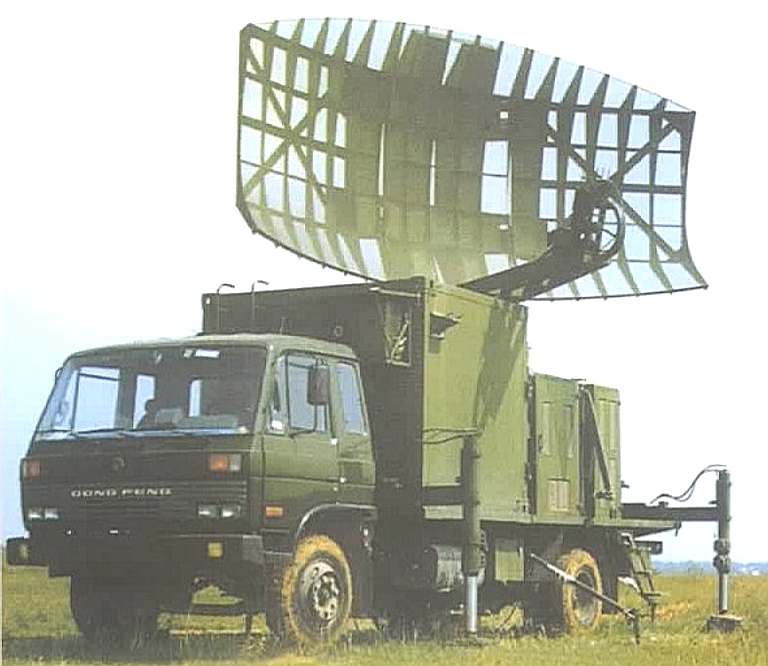
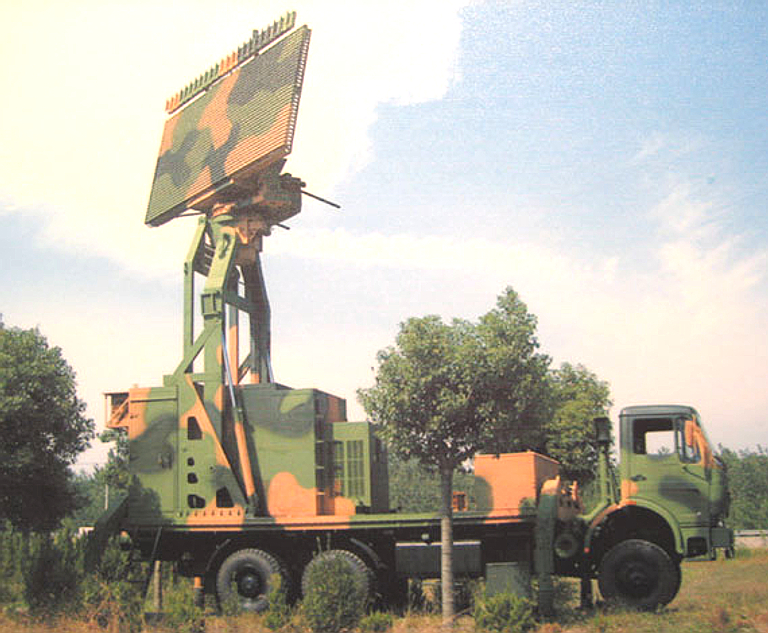
This is a two-vehicle convoy, high mobility, medium-range, low-altitude 3D radar announced by CETC in June 2007 at Singapore.
The reported system features are excellent low-altitude performance with high measurement accuracy, strong ECCM capability.
Specifications:
Operating frequency: EF-band
Coverage: (Pd = 80%, RCS = 2m2)
Range: ≥ 250km
Height: ≥ 12,000m
Elevation: 0º ~ 35º
Azimuth: 0º ~ 360º
Its detection range suggest instantaneous PRF of 600pps thus operational PRF of approx 400 is suspected.
Measurement accuracy: (rms)
Azimuth: ≤ 0.3º
Range: ≤ 100m
Height: ≤ 600m (within 200km)
Assembly/disassembly: 20mins/4 persons
MTBCF: ≥ 1,000 hrs
MTTR: ≤ 30 mins
LY-60 / HQ-64 Acquisition Radar
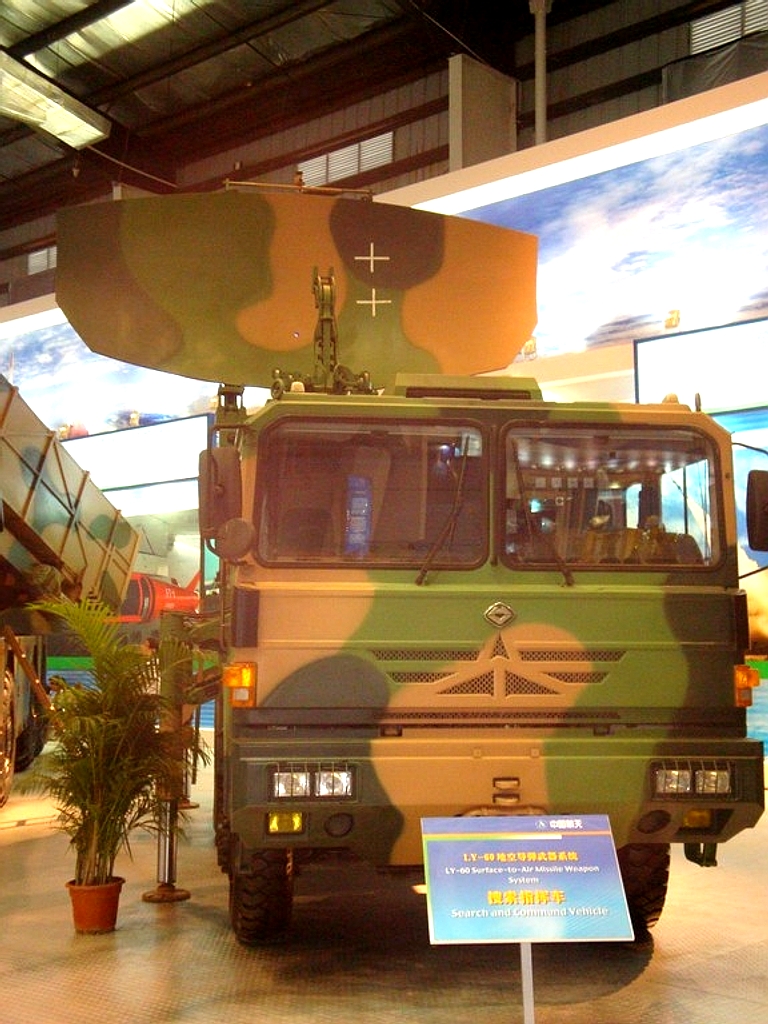
The CPMIEC LY-60 is a direct clone of the Italian Selenia (Alenia) Aspide Mk.1, itself derived from the RIM-7E Sea Sparrow. This missile is frequently cited as the direct replacement for the conceptually similar but much bulkier HQ-61.
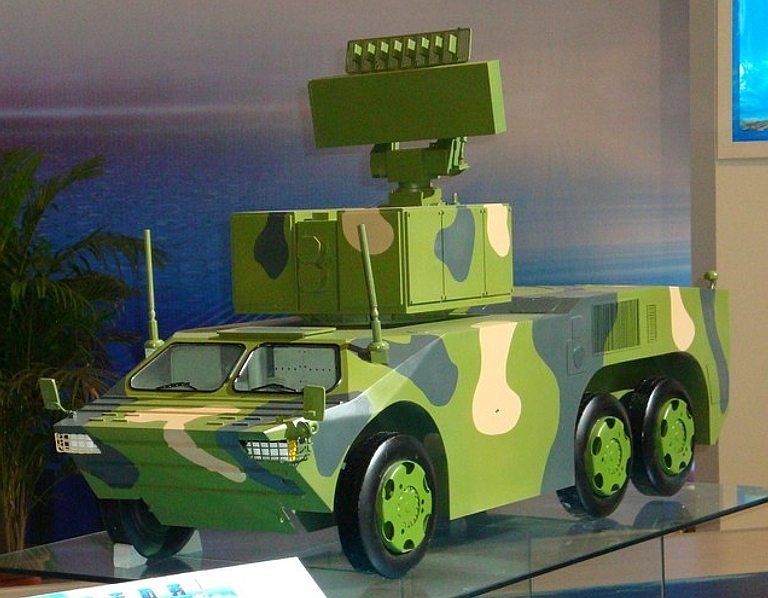
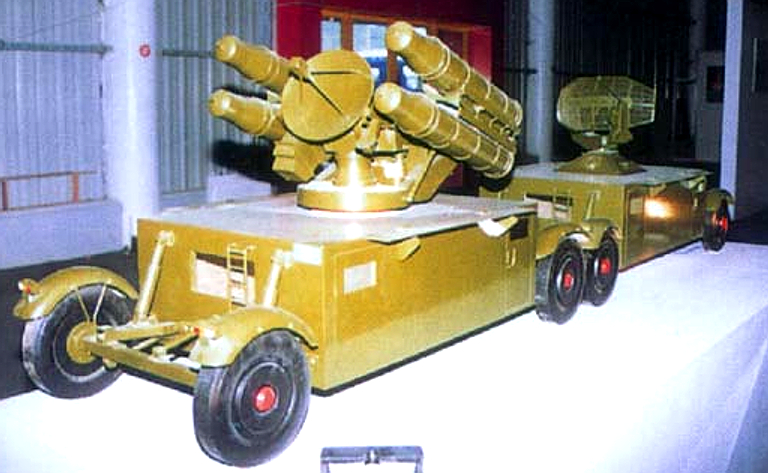
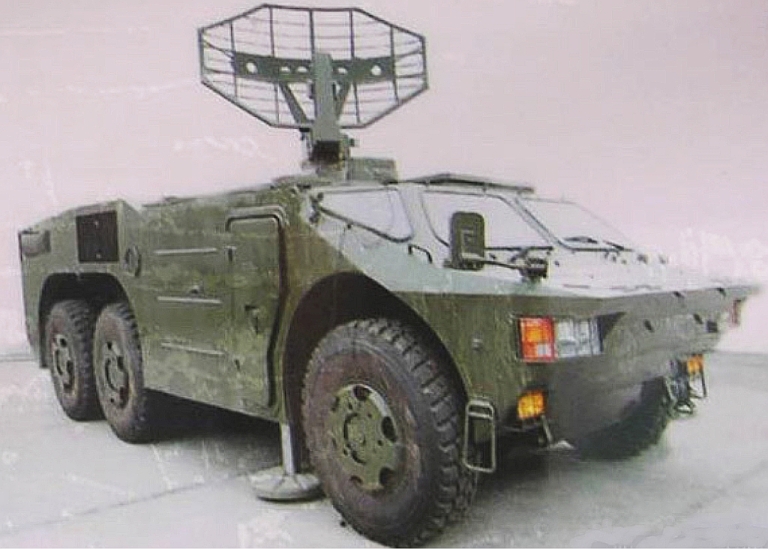
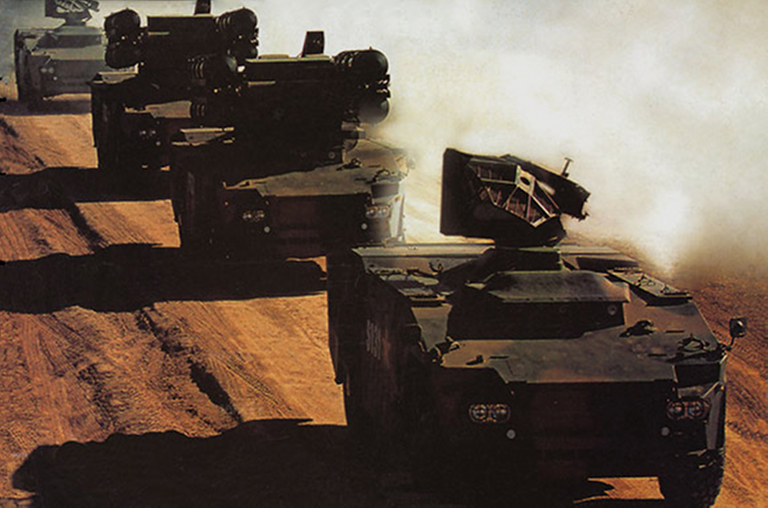
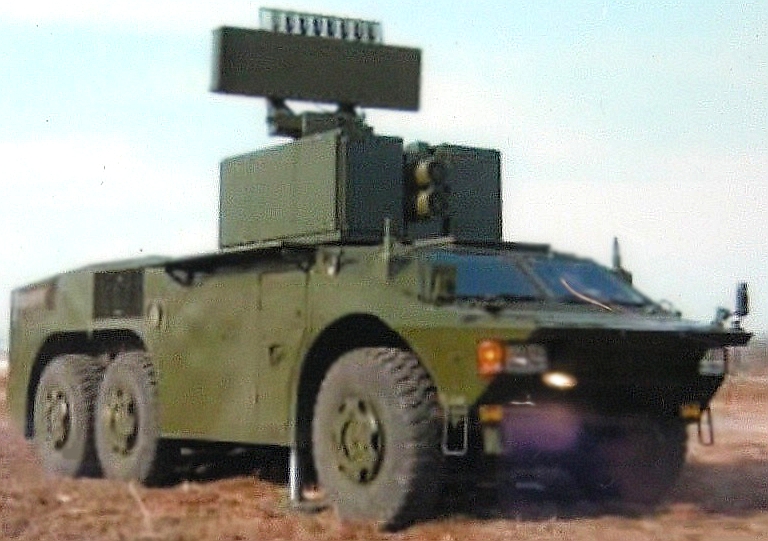

China is reported to have developed its first OTH-B radar back in 1967, although its designation is not known. Since the 1980s two further installations have possibly been added to the inventory, with at least one system looking out into the China Sea area reportedly to target (US Navy) aircraft carriers.
Backscatter systems function at the upper end of the High Frequency (HF) band, typically between 12 and 28 MHz.
OTH-B radars are bistatic systems, this is where the transmitter and receiver use different antennas at widely separated locations to achieve detection results. The importance of these systems is that they are not limited by line of sight, as are most radars, but they do require a very significant amount of processing power. This was the limiting factor with early Chinese OTH systems, but may no longer be the case.
Because of the very long wavelengths involved, to be efficient, the antenna arrays are extremely large as indicated in the picture above.
China's OTH-B is said to use Frequency Modulated Continuous Wave (FMCW) transmissions to enable Doppler measurements, the suppression of static objects and the display of moving targets.
On 14th November 2001 www.china.com reported that CEIEC was (then) developing a new OTH radar because only one system was currently available (presumably the one shown at its web site), which is the one assumed to be sited near the HQ of the South China Fleet at Guangzhou.
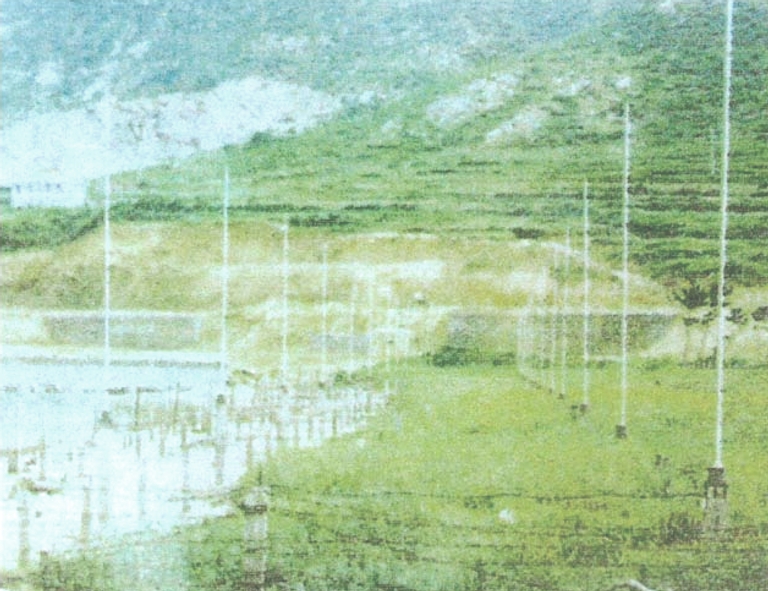
Surface Wave-OTH (SW-OTH) radars are used to detect surface ship and low air activity beyond the visible horizon, out to about 300km, although the absolute range is dependent upon atmospheric conditions, system power and the time of day.
The designation of China's SW-OTH is not known, but reliable reports suggests that she has at least two systems in operation, with one ranged over the Taiwan Straits in 2003.
CEIEC brochures state that China’s SW-OTH system uses FMICW and FMPCW transmissions, which probably translate to Interrupted and Pulsed FMCW.
This system, albeit undesignated, is currently being promoted for export by CEIEC. Two antenna arrays are shown. The single mast may support a Rhombic transmission array whilst the reception array of dipoles appears to be arranged across a bay.
Several dozen technical papers by Chinese authorities have been reproduced in the West concerning OTH systems, including those listed in the footnote (refer book).
Very few pictures of Chinese OTH systems have been made available and those that are, are generally of poor quality. The one above is reported to show a SW-OTH receiver array – across the mouth of a bay - at an unknown location.
Further confirmation of the existence of Chinese SW-OTH systems is supplied by amateur radio enthusiasts (HAMS) intercepts and bearing fixes an example of which is supplied by callsign VE7BZ based in British Columbia, who recorded the radar's signal on 1st October 2006, 1353 UTC, on 3.795 MHz.40 The detected audio is quite a rasping sound. Additional intercepts from California and Arizona place the emitter on or in the close proximity of Hainan Island, although Google Earth searches have failed to identify the location of this source.
What is reported to be a Chinese SW-OTH site has been identified on the coast southeast of Shencheng, in Zhejiang Province. The transmitter is located at 27º 46’ 58.70” North, 120º 45’ 54.41” East, whilst the receiver is approximately 3km southwest at 27º 45’ 26.88” North, 120º 45’ 04.98” East. The control centre for this site is just 1km northwest of the receiver site and is readily identifiable.

Imagery Sources: Chinese Internet.
Line Artwork: © 2000, 2007, 2008, 2009 Carlo Kopp
Technical Report APA-TR-2009-0103
|
|||||||||||||
![Sukhoi PAK-FA and Flanker Index Page [Click for more ...]](APA/flanker.png) |
![F-35 Joint Strike Fighter Index Page [Click for more ...]](APA/jsf.png) |
![Weapons Technology Index Page [Click for more ...]](APA/weps.png) |
![News and Media Related Material Index Page [Click for more ...]](APA/media.png) |
||||||||||
![Surface to Air Missile Systems / Integrated Air Defence Systems Index Page [Click for more ...]](APA/sams-iads.png) |
![Ballistic Missiles and Missile Defence Page [Click for more ...]](APA/msls-bmd.png) |
![Air Power and National Military Strategy Index Page [Click for more ...]](APA/strategy.png) |
![Military Aviation Historical Topics Index Page [Click for more ...]](APA/history.png)
|
![Information Warfare / Operations and Electronic Warfare Index Page [Click for more ...]](APA/iw.png) |
![Systems and Basic Technology Index Page [Click for more ...]](APA/technology.png) |
![Related Links Index Page [Click for more ...]](APA/links.png) |
|||||||
![Homepage of Australia's First Online Journal Covering Air Power Issues (ISSN 1832-2433) [Click for more ...]](APA/apa-analyses.png) |
|||||||||||||
| Artwork, graphic design, layout and text © 2004 - 2014 Carlo Kopp; Text © 2004 - 2014 Peter Goon; All rights reserved. Recommended browsers. Contact webmaster. Site navigation hints. Current hot topics. | |||||||||||||
|
Site Update
Status:
$Revision: 1.753 $
Site History: Notices
and
Updates / NLA Pandora Archive
|
|||||||||||||
|
|
Tweet | Follow @APA_Updates | |||||||||||
|
|
|||||||||||||
|
|
|||||||||||||
![F-111 Aardvark Index Page [Click for more ...]](APA/f-111.png)
![F/A-18 Hornet and Super Hornet Index Page [Click for more ...]](APA/fa-18a.png)
![Aerial Refuelling and Airlift Capabilities Index Page [Click for more ...]](APA/aar-lift.png)
![Directed Energy Weapons and Electromagnetic Bombs Index Page [Click for more ...]](APA/dew.png)
![Notices and Updates Index Page [Click for more ...]](APA/notices-128.png)
![APA NOTAM and Media Release Index Page [Click for more ...]](APA/notams-128.png)
![APA Research Activities and Policy / Technical Reports Index [Click for more ...]](APA/research-128.png)
![Search Air Power Australia Website [Click for more ...]](APA/search-128.png)
![Briefings and Submissions - Air Power Australia [Click for more ...]](APA/briefs-128.png)
![Air Power Australia Contacts [Click for more ...]](APA/contacts-128.png)
![Funding Air Power Australia [Click for more ...]](APA/funding-258.png)
